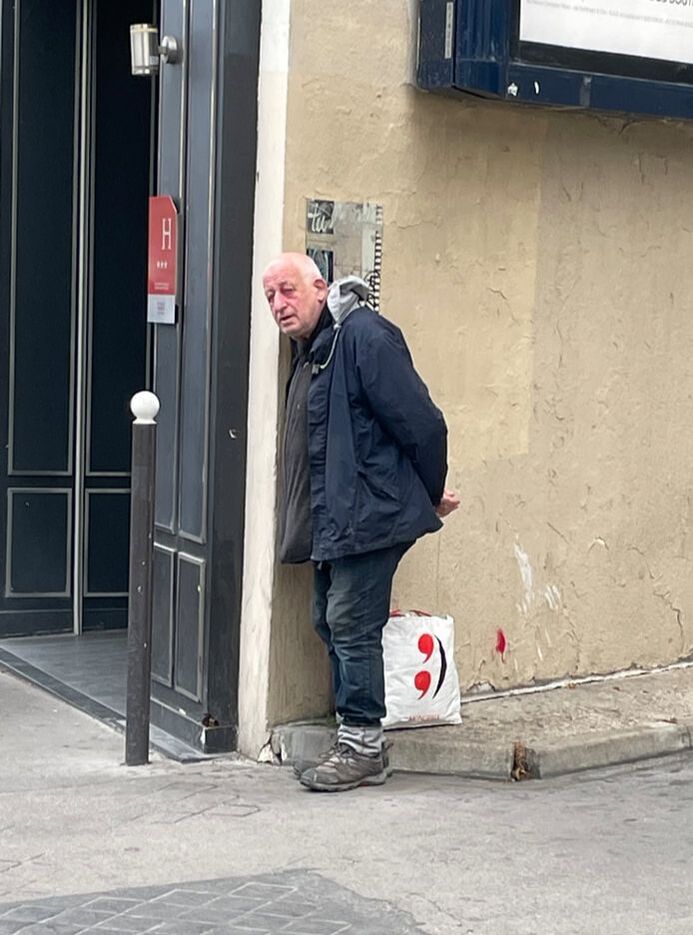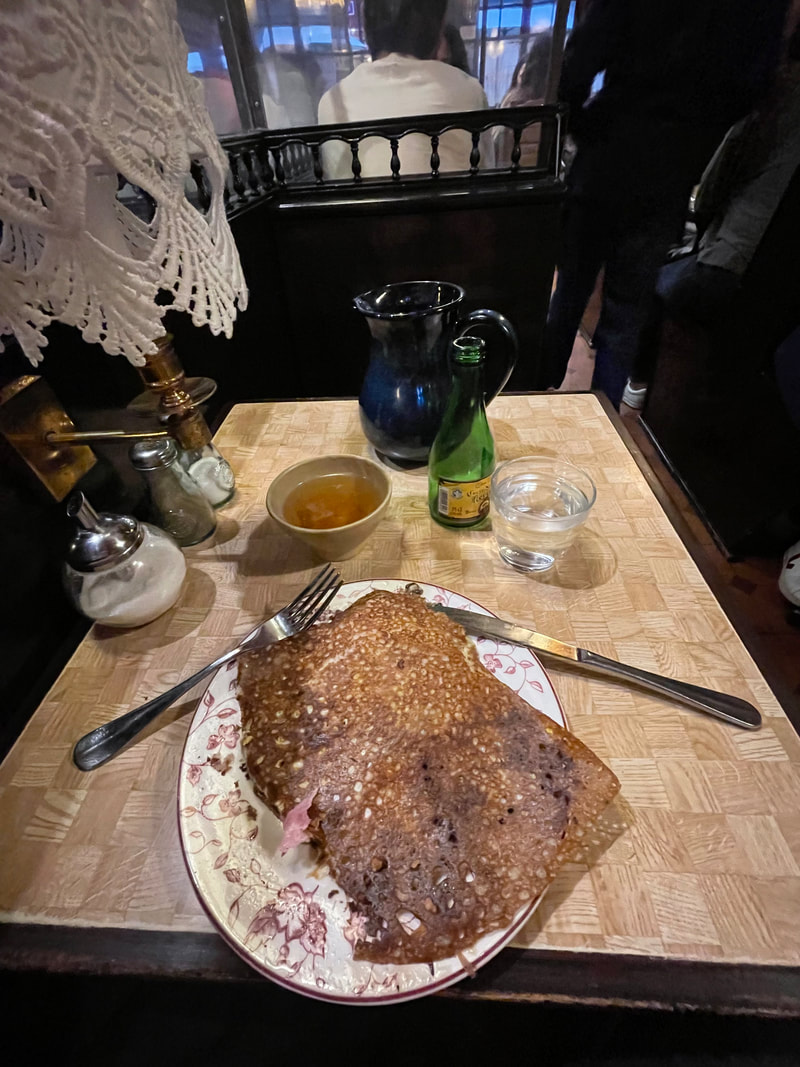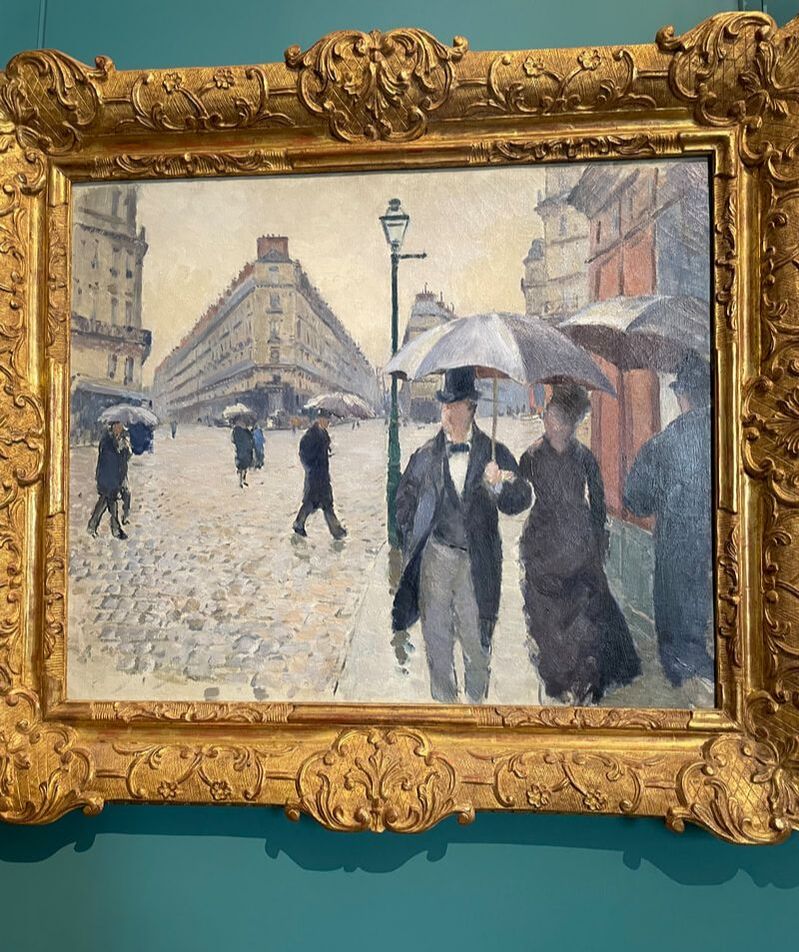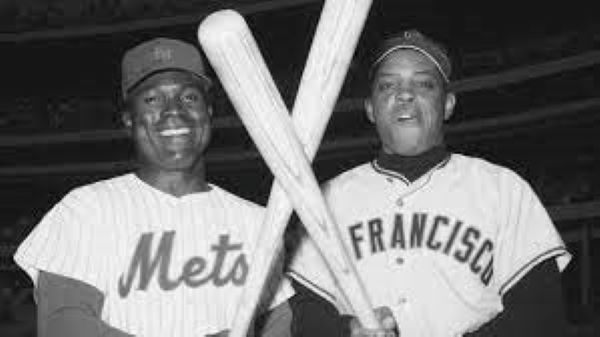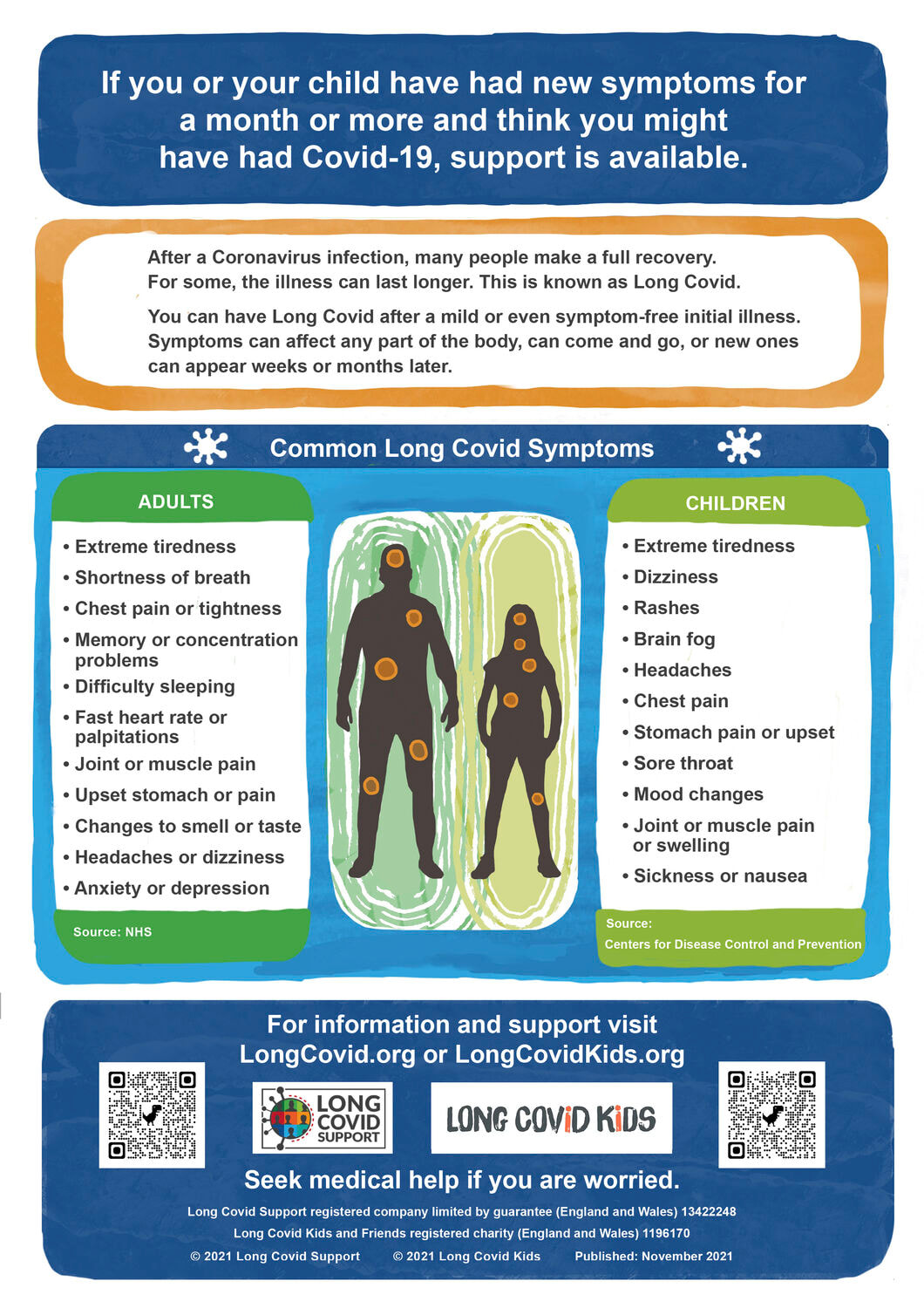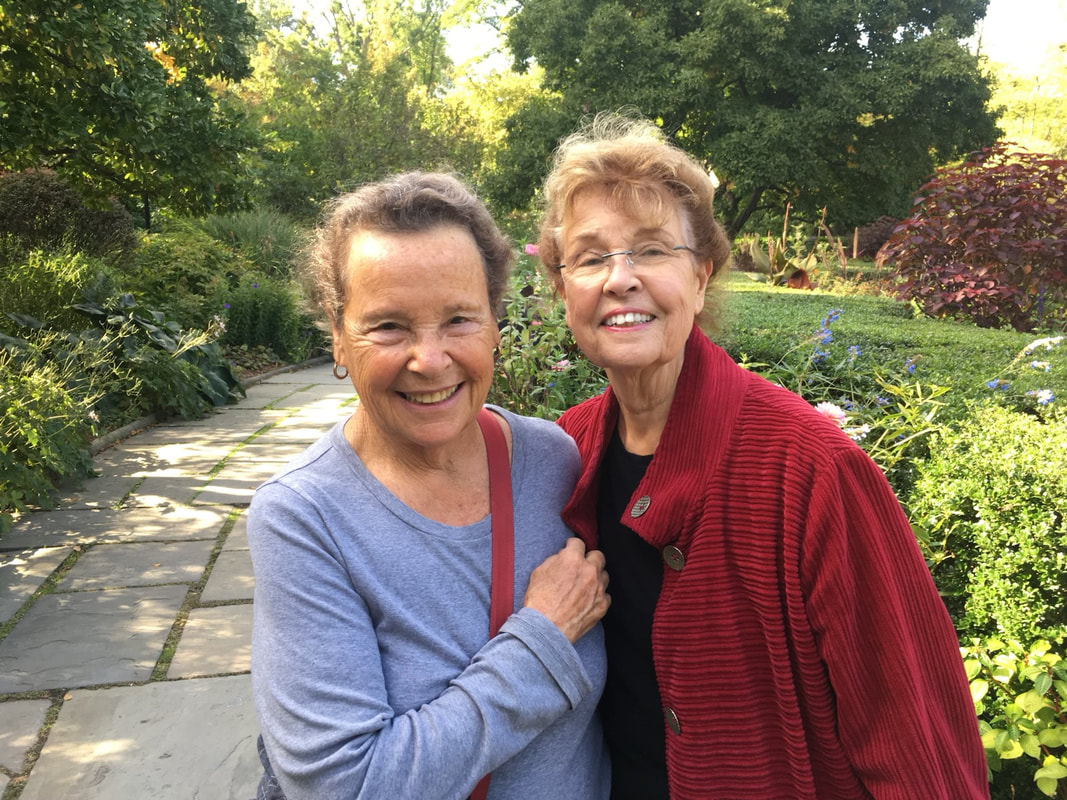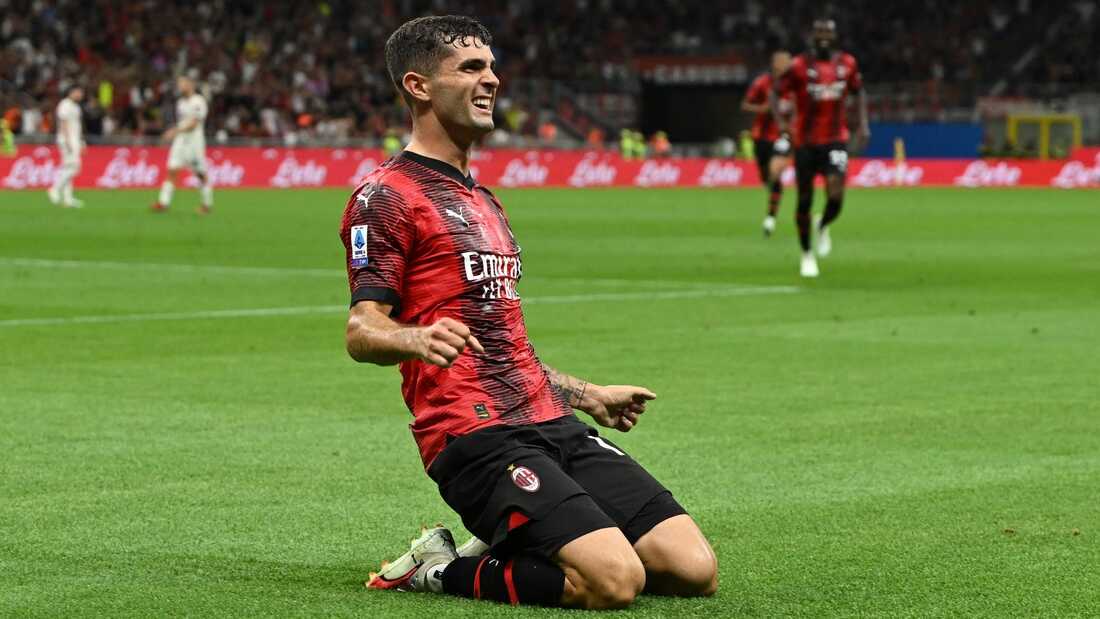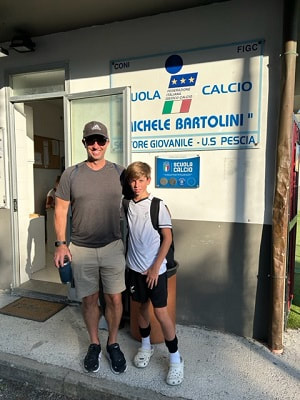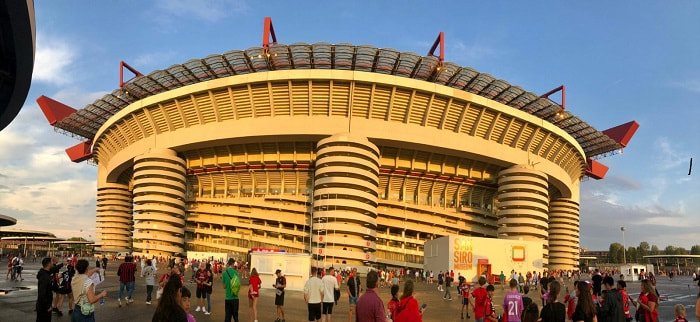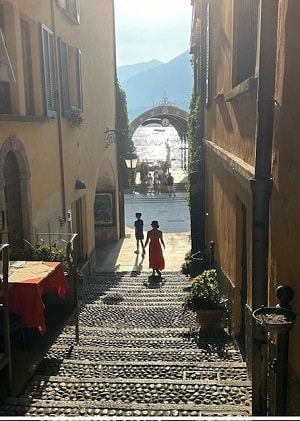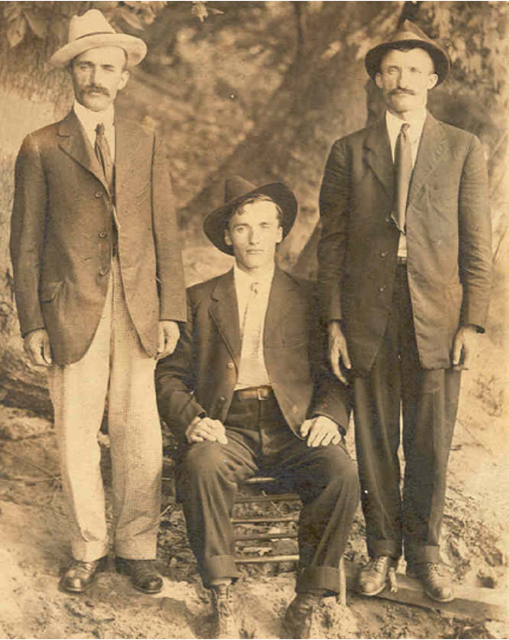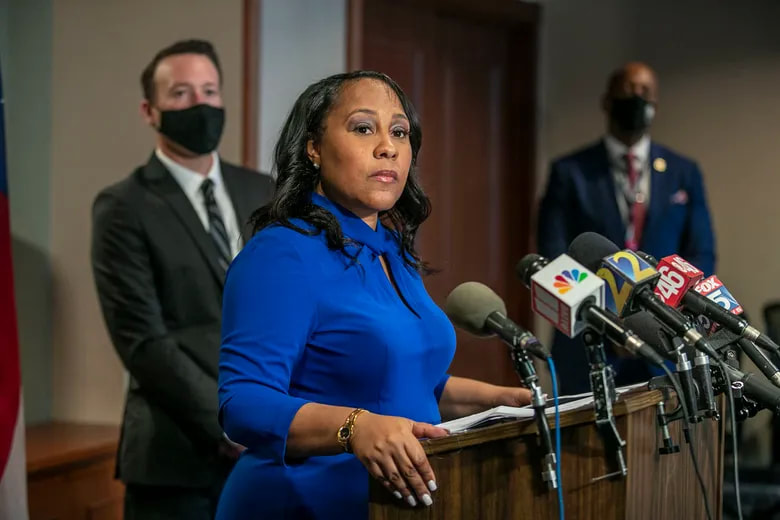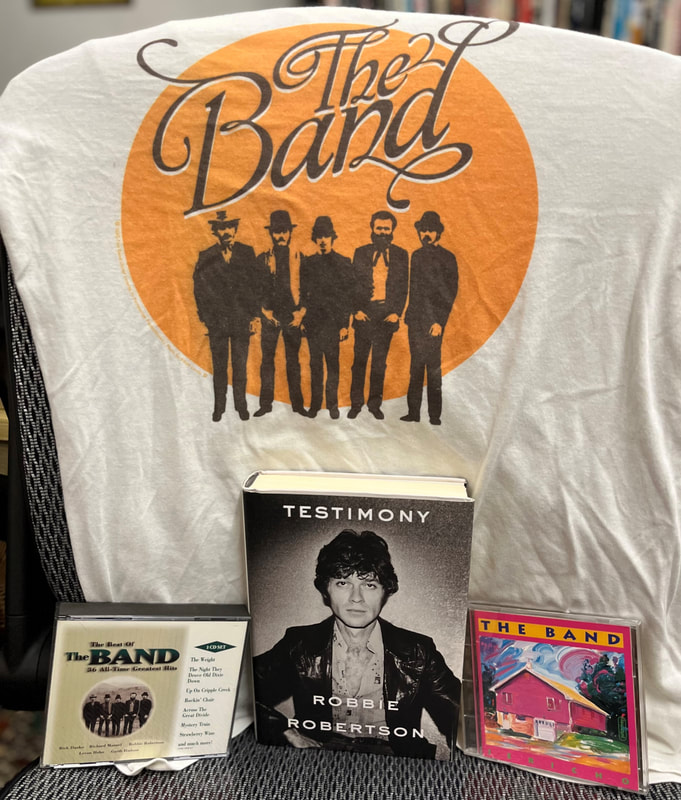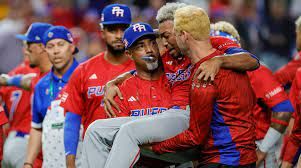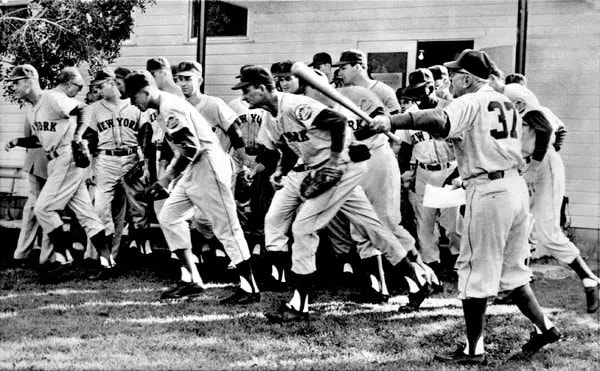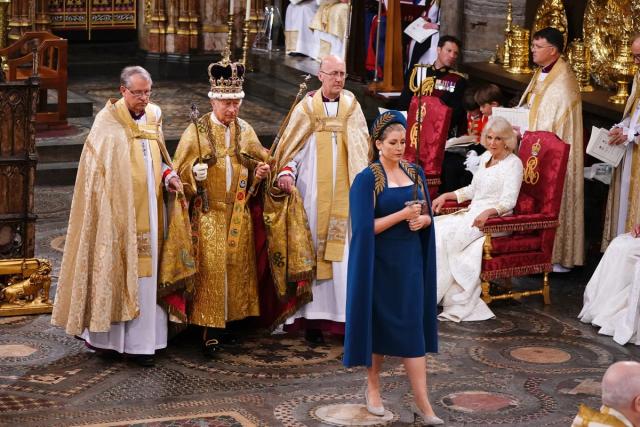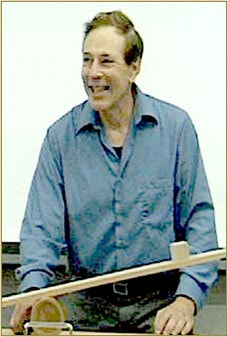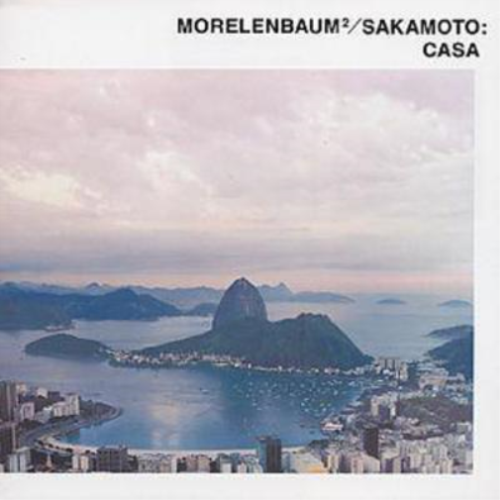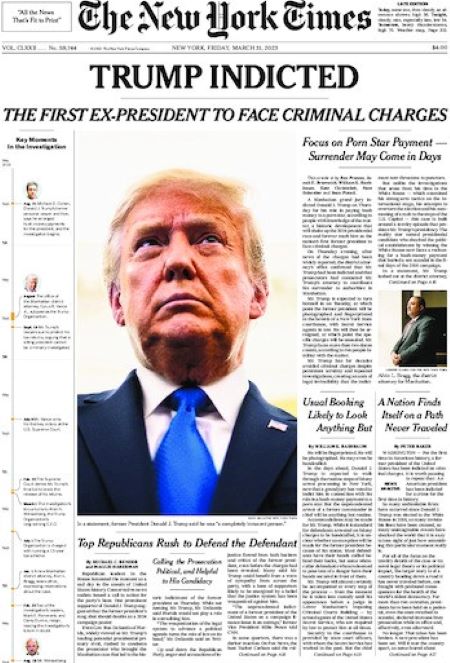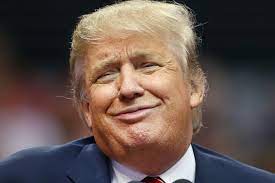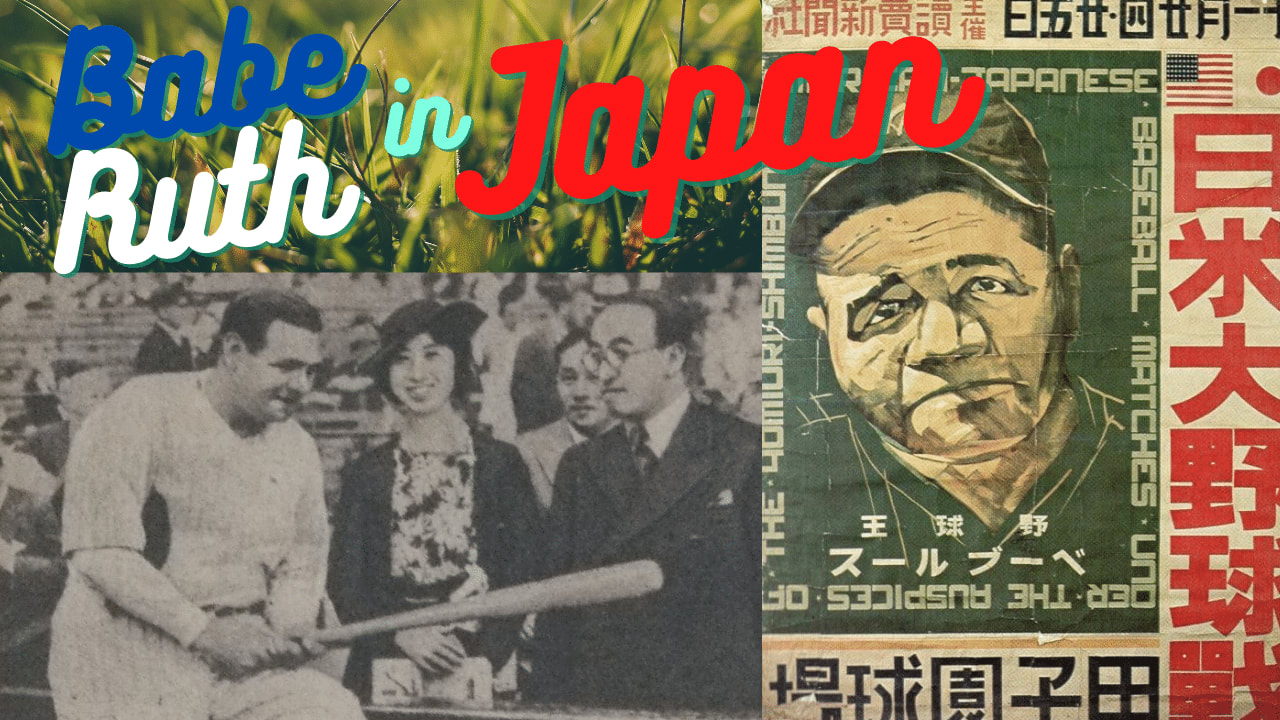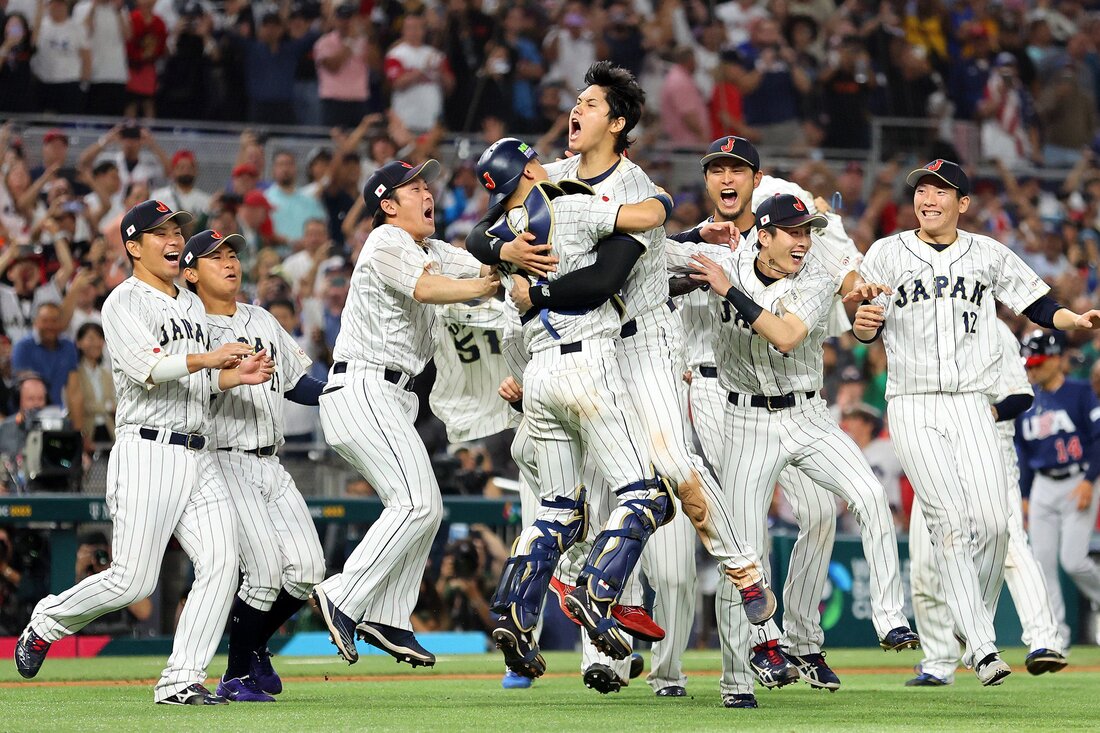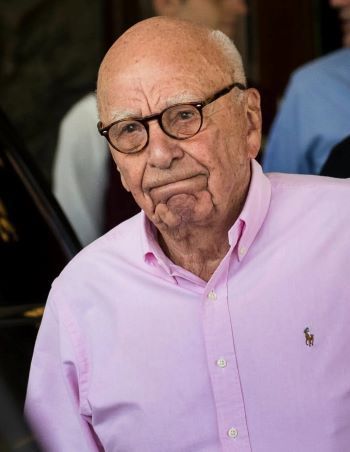 Another Saturday, another meeting. Our man in Paris, Bruce-From-Canada, caught up with his old friend at the same corner. "About 10 seconds after I took this zoom photo—around 1030 or so—he gathered his things up and started walking in my direction. I moved over and got a little in front of him and offered. He only glanced. usually seems to study for a few seconds. looked at me and said, 'merci beaucoup, bonne journee' and continued on this way. Wonder if he'll miss me next week?  Earlier in this travelogue, Bruce told about his annual meeting with the man in the arrondissement -- the ritual potatoes, the thank you, in English. Bruce went back yesterday and found the man at his corner, and gave this succulent-looking helping of pommes de terre. This time, Bruce reports, the man thanked him, in French. (This sounds like a classic O. Henry New York short story, Bruce, so we are waiting for the next episode. A demain. )  Every October, Bruce goes back to the same neighborhood in Paris, and pretty much does the same things, as far as I can tell. Which is wonderful, considering that it is Paris. You know Bruce. Frequent contributor to this little website, from his regular enclave in the True North Strong and Free. Retired journalist. Former resident of Japan. And very good at pointing out the foibles of that nice benign country just below his. In our email, he counts down the days (the hours) until his next jaunt to Paris. Every year I call him a showoff, a dog, a provocateur, but knows I love showing his perambulations to my family. We made these same rounds, decades ago, once with our three children one sweet damp April. April In Paris. One more time. This year -- with all the horrors in the world -- Paris, Bruce's Paris, his corner of Paris, seems sweet and benign. So let's go with Bruce. Bruce writes: Three years ago i saw this guy standing about 50 metres from the Edgar Quinet marker near Montparnesse Market. I gave him half my potato fry and he took them without a word for the three consecutive weekends i was there. Last two years, also, I walked past the spot again today and he was there. I offered them to him today and he took them. Don't think we've said word - but today he said, "Thank you"-- in English. Ray (owner) insisted I have a cider—it was really good. Then told me he'd give me a full bottle to take back to canada when i leave. I had to turn him down since I have carry-on and liquid restrictions. (To which George adds: "Quel dommage.") (Presumably not the same meal): Creperie Montparnasse  GV: Not a day or night goes by without a photo from some angle. Fine by me. We all have memories of Paris. Marianne and I remember our pal Greg driving around Paris in his convertible on a sparkly summer night after the Tour de France, circling the Tower once, twice, three times, like a championship lap, and Tout Paris sparkled like this. I am so thrilled that the New York Times obituary editors ran a lovely obituary of Joe Christopher, a member of the early New York Mets – and my friend over the decades.
Joe touched a chord in me because he was mysterious and deep. I have learned more since he passed last week, from his daughter Kameahle Christopher. I also collected memories of Joe from two of his old teammates. In case you miss the NYT obit, here it is (for those who can access it). It is written by Richard Sandomir, now an obit writer, but previously a star sports-media critic (back when the NYT had a sports section.) https://www.nytimes.com/2023/10/05/sports/baseball/joe-christopher-dead.html I became intrigued by Joe Christopher in the first year of the Mets when he was a backup outfielder. Joe was from St. Croix, apparently the first player born in the Virgin Islands to play in the major leagues. He was a mix of cultures and languages, introverted, but also comfortable chatting with some of the young Chipmunk writers covering the club. “I’m a better ballplayer than you guys think I am,” he would say, softly. Sometimes he would chat with me about mysterious religious trends. I don’t claim I understood, but I think he sensed he had a friend. He was up and he was down with the Mets but in 1964 he played regularly and batted .300. (The obit tells how in the final game he dropped a bunt single in front of old Ken Boyer of the Cardinals to pretty much clinch the distinction of being a .300 hitter. In the pressbox in St. Louis, I almost cheered out loud.) His career sputtered again in 1965 and he was soon gone from the majors. Recently, two former teammates had nice things to say about Joe: Larry Elliott, a fellow outfielder in 1965, sent this memory: “I was trying to break up a double play against Philly. I did not get down in time and Ruben Amaro hit me in the back of my head with a throw. It was my fault. I was in the hospital for five days and Joe was the only one to come and visit me." My e-pal, Bill Wakefield, sent his memory of 1964, when he was a rookie out of Stanford and reported to the Mets’ spring hotel in St. Petersburg, Fla. “The front desk says, yes, we will give you a room, and assign your roommate. So I take my suitcase to the room. Open the door, and inside is a startled Joe Christopher. I said, ‘I’m Bill Wakefield and I’m your roommate.’ He seemed surprised but said, fine” (Wakefield doesn’t need to note that Blacks and whites were not rooming together in those days. And Christopher, who had been introduced to segregation in the U.S., was surely aware of that.) Shortly, Wakefield received a call from Lou Niss, chain-smoking, worry-wart travel secretary of the Mets “Come to come to the lobby immediately. I assume it's to get instructions -- don't drink in the hotel bar -- that's Casey's spot -- don't be late for the bus -- wear shower shoes on the bus not spikes, etc. “He says – ‘ Bill we are moving you in with Larry Elliott -- make the change immediately.’ And sort of as an afterthought, he said -- I paraphrase – ‘Baseball has made progress but we are not ready for black and white roommates yet." “I have no idea -- I just want to do all the right things. So I go back down to the room -- Joe is still there -- he kind of smiles at me -- and I said Lou Niss has assigned me a different room. “I always worried that Joe thought I had complained and that was the reason for the switch. I really didn't care. "So I packed up and moved to Larry's room.Joe never mentioned it again. He and I became pretty good friends. “Joe and I laughed about it over the course of the season. He even got a big smile on his face and would say ‘Nice going, Roomie!!!’ Great guy.” I have one more memory of Joe, who could wiggle his ears with the best of them. A knot of Mets writers were taking the sun behind the Mets’ dugout during a game in Chicago in May of 1964. As the Mets frolicked to an unforgettable 19-1 final score, Joe would trot in from right field after each inning, levitating his cap with his ears – just for the writers’ sake.” Joe’s major-league career fizzled but we kept running into each other. In the late 60s, I was in Puerto Rico writing for Sport Magazine about Frank Robinson managing a team in the winter league. I was at a game in Caguas when I spotted Joe playing for Santurce…and we agreed he would ride back in my rental. Then he won the game with a grand-slam homer in the ninth inning and the fans were so annoyed that they made motions to tip my car over. We laughed about it all the way back to Santurce. I always reminded him how he almost got me killed. Joe and I ran into each other in the 1980s near Times Square. He was carrying a large rectangular portfolio used by artists to protect their work. He came up to the Times for a while, but I never saw his work -- part of the mystery of Joe. The other day, I chatted with Kameahle Christopher, a paralegal with Amtrak, who lives outside Baltimore, and asked about her dad’s inner life. “He was interested in pre-Colombian art,” she said. “He was in touch with the ancients, the Olmecs and Mayans. He was into numerology…would ask your birthday, would predict things,” Kameahle said. “He was gifted spiritually.” I asked her about her dad’s childhood and she said he was raised in Oxford, a small settlement in St. Croix. “He grew up in a small house in the mountains,” she said. “He walked everywhere, and when he came home at night, he learned to follow the North Star. He said, “‘I’m not going to grow up like this.’ Nobody had ever left the islands. He endured hardships, but he used to tell himself, ‘I’m Joe from Oxford…and if I have to walk, I’ll walk.” In his later years, Joe wanted a job teaching baseball; “he carried his baseball gear in his car,” Kameahle said. Joe would coach somebody for the joy of it, remembering how much he had learned from coaches like Rogers Hornsby, Sheriff Robinson, Paul Waner – and his driven roommate with the Pirates, Roberto Clemente. After talking with Kameahle Christopher, I felt I knew her dad better – where his inner strength came from, standing in the clubhouse, a marginal Met, telling young writers from New York: “I’m a better ball player than you guys think I am." Kameahle’s loving portrayal made me miss him even more. ## It was only yesterday that I was echoing Mark Twain (or whoever said it about the weather) when I suggested, everybody talks about Long Covid but nobody does anything about it.
Well, at least I just found another current study, this one from the CDC,. My main takeaway from this one is that nearly twice as many women as men have Long Covid. Thsi echoes a mini study done in our household, when the female has more symptoms than the male. (see CDC link directly below:) https://abcnews.go.com/Health/18-million-us-adults-long-covid-cdc/story?id=103464362 And then there's this: Long COVID patients have clear differences in immune and hormone function from patients without the condition, according to a new study led by the Icahn School of Medicine at Mount Sinai and Yale School of Medicine. The research, published in the September 25 issue of Nature, is the first to show specific blood biomarkers that can accurately identify patients with long COVID. www.mountsinai.org/about/newsroom/2023/people-with-long-covid-have-distinct-hormonal-and-immune-differences-from-those-without-this-condition
Sometimes it’s called Brain Fog. Comes and goes, like coastal fogs, but more dangerous. That ache in one limb or another that cuts down on activity and mobility, leading to expensive and grueling trips to medical centers that do not lead to any result except they found nothing. Recently, The New York Times ran, in the invaluable Health Section, an essay by Paula Span called “Long Covid Poses Special Challenges for Seniors.” It proposes that Long Covid is real and formidable and must be acknowledged before we can adapt to it. Span writes about a librarian in Michigan who was walking all over Ann Arbor, often four miles a day, until she got whacked in March of 2020, before most people had been warned by any responsible agency or government. “The virus caused extreme chills, shortness of breath, a nervous system disorder and such cognitive decline that, for months, Ms. Anderson was unable to read a book.” Still, people search for information beyond the glib explanations on the tube and the dismissals by people who think the pandemic is over, or harmless, or never existed. (I hear that even in a generally enlightened corner of the world.) On Sunday, I saw Dr. Anthony Fauci on TV on Sunday. Can’t remember what channel or what host. (Brain Fog, indeed.) But his words were current, and my general memory of the interview was that “they” or “we” still do not know much -- and Brain Fog generally may be an explanation for….whatever. On Monday morning, I poked around online to see what is available. First, since the government has apparently decided Covid is serious again, I signed up for four free test kits, via: https://www.covid.gov/tests Next, I found an article from the New York Times from only two days ago, warning that a cold virus could set the stage for Long Covid. https://www.nih.gov/news-events/nih-research-matters/cold-virus-may-set-stage-long-covid Then I found an article that says women have a 50 per cent higher chance of developing Long Covid than men https://www.nytimes.com/2023/03/23/health/long-covid-risk-factors.html My general impression is that the major health institutions are just beginning to acknowledge/study Long Covid. Stay tuned, if you can still focus. However, the Web does include examples of people and regions that were taking Covid – and it’s long-form product – seriously. For example, I found a site from the UK that included a graphic about Long Covid for adults and children. (It’s from 2021 but it seems relevant -- more than ever.) It disclosed contacts for support groups in regional areas in England and Wales. Print it out. It is ideal for the refrigerator door and could also be stored in a cellphone for display when people start proposing indoor activities. Recently I met some of my longest friends – outdoors, in a park all of us know. It was wonderful – and made me realize all over again the fellowship I have missed in the past 3 ½ years. (Two of 20 came down with Covid within days and are doing okay.) Last fall (don’t tell anybody) I went to a memorial for two of my Spencer cousins, in deepest New Jersey. I absolutely had to be there, and am deeply happy that I saw other cousins, caught up on decades of life. I credit my safety to God’s grace. Some people seem to be going everywhere, doing everything. They know the stuff is all around us, but they go. Occasionally, we take a huge psychic breath and see a good friend or relative indoors, but generally, even for family reunions I recite my internal recorded announcement – that this stuff keeps morphing, and we just can’t take many more chances. Meantime, with deep sorrow, I am ducking a large gathering of good friends and colleagues in a crowded pub because I just can’t afford the flying molecules while laughing, crying and hugging. We two elders are hunkering. We’ve had two, maybe three, cases of Covid. The one at the end of 2022 was brutal, followed by a very wet and sloppy case of RSV, I think. Happy new year, indeed. When we go to our very good doctors, we talk of our trying symptoms of Long Covid. The doctors acknowledge it, and they take care of us, and we try to wait out Long Covid, whatever it is. *** Nice visual of Long Covid from the UK. 2 years old and counting. (My colleague Harvey Araton and the standout current reporter Jenny Vrentas have written about the NYT disappearing its sports section. Please open the link below.) https://mailchi.mp/nyguild.org/happening-today-farewell-to-the-sports-desk?e=5db07bd5c6 AT THE END OF WHICH I QUOTE THE BOSS
(You know which Boss) Everybody needs a happy new year.
Rosh Hashanah arrives Friday, with fallish weather -- at least, that is the New York tradition. I remember one Rosh Hashanah, we had visitors, a couple we love from "out west," and we went out for dinner to a Greek restaurant, a couple of towns over from us. The weather was so early fallish that the restaurant had opened some windows up front, to let the crisp air enter. A group of celebrants from a nearby temple was passing the restaurant. They were in a bouyant mood, and spotted the four of us at the window. One celebrant asked the question you often hear on city streets from the faithful seeking to expand the flock: "You Jewish?" (Pronounced "Joosh?") Three of us pointed at the fourth, a Jamaica High grad a few years younger than me. The Judge. That made the roving band happy and they began serenading us through the open window, shofar blaring. That made the four of us happy. We were home. In New York. * * * There's a lot of bad stuff these days. War. Floods. Earthquakes. And to employ the generalization, "politics." But I'm taking the blue sky and bright sun as a Rosh Hashanah sign that things are okay, at least as I type this. I'm sending out greetings to friends and to family, including my Australian second cousin Jen and her New York husband Sam, undoubtedly celebrating in their way in their lovely little village in Southwest France. And to my New York-born friends, some of whom pop up in Comments on this page, who have made Aliyah, that is, moved to Israel -- Mordechai, Hillel and Mendel, and his NYC dad Ahron, seen dancing with quick feet at family celebrations. L'Shana Tovah. *** And then there is this. Back in the day, Jean W and Jean R were friends at PS 131, not far from Jamaica High. They did stuff together, right through high school, went to separate colleges, and then Jean R made aliyah, to a kibbutz. After a time, Jean W visited Jean R in her kibbutz, and then showed us photos in a luncheonette along Union Turnpike. The other day, a bunch of us from the Class of 1956. living not far from Cunningham Park in Queens, gathered for an informal BYO picnic, under trees that must have been growing when my mother and my Irish Nana were swinging me in the nearby kiddie park, still standing. Familiar park. Familiar faces. As 20 or so gathered, we talked of others ("Good friends we had/ Good friends we lost/ Along the way" -- Bob Marley, "No Woman No Cry.") And in the center of the group was Jean W, sitting alongside Jean R, back in New York for a family visit. It made me immensely happy to see these two friends, as if it were 1950. *** L'Shana Tovah. Happy New Year. It's universal, at least where I'm from. Brendan LoParrino and his teammates had an interesting summer vacation. Their soccer club in Putnam Valley, N.Y., visited Italy, trained at the facilities of the fabled AC Milan squad, and attended a Serie A match at San Siro. Christian Pulisic, the scoring star of the U.S. national team, moved from Chelsea to AC Milan during the off-season, and he was in the lineup for the match with Torino. Not only that, but Pulisic scored one of his typical goals – sharking the side of an attack, waiting for the ball to come loose, and when it did, Pulisic kicked it into the far left corner. Only Pulisic knows if he had spotted a noisy American contingent in the second deck, but that side was the closest to his goal, and he slid on the grass to celebrate as the crowd cheered, syllable by syllable: “Pu-li-sic! Pu-li-sic!” That goal was not guaranteed in the prospectus for the training week -- and players and adults from New York appreciated it. For American elders still boggled by the popularity of soccer in the mainstream of culture, this summer camp – a luxury, to be sure – demonstrates the hold of the world’s most popular sport on the younger generations, well into middle age by now. Brendan LoParrino even carries a nickname, based on Jordan Henderson, the smooth and unselfish former captain of Liverpool, and also leader of the English national team (now playing for big bucks in Saudi Arabia). Brendan’s teammates call him “Hendo,” Henderson’s nickname, and during a training match, the opponents heard the nickname being shouted, and asked what that was all about, so the Putnam Valley players filled them in. Soccer is a language all its own -- and spreading around the U.S. Brendan, age 13, going into eighth grade, recalls the trip: “Our team started training before traveling to Italy. We had normal training during the week at our club. We also had two practices in Italy, one with our coach, Angelo, and another with a professional trainer. “I was not sure what it was going to be like in Italy. I was excited and felt that the players there were going to be really good." He added, “I do not think soccer was that different and thought it was better in Italy. They have nice training facilities and I liked the locker rooms. The watermelon was really good at the concession stand. The coaches were more relaxed and let their players play. “I learned about playing with kids from different coaching styles. It was also different playing in such hot temperatures.” "Our first game was against Pescia. It was 102 degrees and we won. I scored two goals and one was on a free kick. We then visited Coverciano/museum and trained in the morning. We tied the next game against Fornacette in Tuscany. "We controlled the ball but could not score. The next day we went to a professional game at San Siro stadium. AC Milan played Torino. AC won, 4-1, and both Giroud and Pulisic scored. This was the best professional game I have been to. We lost in our last game against (Pro Sesto) and they were very good. They are the youth academy for the Serie C team in San Giovanni, Lombardy.” The trip was not all soccer. The group made a side trip to Lake Como and took the ferry, visited Montecatini Terme and Florence.
“We climbed the Leaning Tower of Pisa with my sister Kaitlyn. I was happy to get soccer jerseys for AC Milan, Italy and Juventus." Clearly, the vast majority of American youth players do not have the luxury of an overseas trip, but spend the summer working on their skills much closer to home. Youngsters who do get to make a trip like this can bring home the feeling of how much soccer means to the fans – the tifosi – whose loyalties are often inherited at birth. That comes across on television in the U.S. – and also in the fast-growing Major League Soccer with its middle-sized stadiums and rituals and traditions. Soccer is here to stay, and young players like Brendan LoParrino are fortunate enough to bring some of that ambiance back home with them. Brendan said: "I look forward to this upcoming season with my core team at Palumbo soccer club. We joined a new league and will be playing teams further north that are competitive. We have a tournament in Orlando this December and one next season in Portugal. I will be playing JV tennis this year and look forward to playing varsity soccer at my school. I am alsolooking forward to the World Cup in 2026." The U.S. and Canada and Mexico will host a North American World Cup, "only" 32 years after the U.S. was host to a World Cup that filled stadiums from coast to coast and made millions of new fans. The U.S. has not come close to winning a World Cup -- but the younger generations have their hopes, respectful of the history of soccer, over there. *** Thanks to Brendan for sharing his impressions via his dad, Joe LoParrino. I know Joe through a mutual friend, the garrulous and knowledgeable Alan Taxerman, an athlete and lawyer who worked with Joe LoParrino. Big Al often shared his strong pro-Yankee and pro-Mantle opinions with the world. through this site. When Big Al passed in 2018, Joe LoParrino invited me to a memorial I could not attend. We have never met, but we are bonded through our mutual friend, and now soccer. Thanks to Big Al, and Joe, and Brendan. (Randy was on a writing burst so I am including this. GV.)
By Randolph Fiery Geneva’s father, Robert Martin Zando, on the left in the photo of the three brothers, was an Italian stonemason and builder from Falcade, Italy. I think he first came through Ellis Island in 1910. He had built a large stone home in the Dolomites, not very far from the Austrian border. He was saving money to bring my grandmother, Caterina, and my uncles and aunt, Sixtus, Abraham and Mary to America, when World War I broke out. The Germans turned their large stone house into an officer’s home and office. My grandmother and the children lived in the attic and cooked, cleaned and were in essence servants to the German officers. My uncle Sixtus was a teenager, and they put him in a work camp. Because of the war, my grandfather was unable to bring grandmother and the kids to America until 1920. They settled in West Virginia because there was a need for stone workers to build structures for the mining industry. My grandfather was one of the first men building the beautiful stone bridges on the Skyline Drive and Blue Ridge Parkway. He also built a building – now in the national historic register -- made of coal in Williamson, West Virginia. My mother was the first of the family born in America and in 1940 or 1941 she was able to enter West Virginia University and receive a degree in biology. But I have an even better story, her older brother, Sixtus was a teenager when my grandmother and the three kids arrived at Ellis Island. Sixtus had a damaged leg and the officials at Ellis island labeled him a “cripple.” They were going to let my grandmother and two of the children enter America, but they did not want to let that “cripple boy” come in. My mom told me, that her mother and her siblings waited for days, if not weeks trying to get Sixtus allowed to enter America. She said her brother was prepared to go back to Italy and live with the family, but they somehow got the officials to finally let him in. They moved to the coalfields of southern West Virginia because there was lots of stonework to support the coal industry. Sixtus was a teenager with a damaged leg and they placed him in a first grade classroom to learn English. That young “crippled boy” did OK. He ended up graduating from medical school at Loyola University in Chicago. He had the money to pay for my mom going to college. Another side story: during my mom‘s senior year in high school, she won an academic scholarship to a small college in West Virginia. When they found out she was Catholic, they took away the scholarship. She worked for a year, and then her brother paid for her to go to school. She was the best human I have ever known.  Randolph Fiery often sends me photos of his garden's produce -- the showoff. Randolph Fiery often sends me photos of his garden's produce -- the showoff. (Randolph Fiery is a regular on this website, with his spiritual passages and frequent odes to the vegetables he grows in southern Virginia. On Tuesday he sent the following :) Can you deny, there's nothing greater Nothing more than the traveling hands of time? Sainte Genevieve can hold back the water But saints don't bother with a tear-stained eye -- Son Volt (rock band) Friends, The sun has not risen in the eastern sky. Yet I am awake and thinking about those “traveling hands of time……." The three men in the photo are brothers: a photograph taken more than 100 years ago. Three brothers, who came through Ellis Island separately between 1910 and 1917. But on this day, they stood together in New York City to have their photograph taken. A recognition of their struggle to come to a new land. It would take another 10 years for them to earn the money, to weather the storm of World War I and bring their wives and children to this new land they called America. It is a family story. A fading story held by a few and controlled by the “traveling hands of time.” They were men who could grow gardens. Tomatoes, basil, potatoes were their friends. And yes, grapes… they knew how to make wine. They knew how to cut stone, build houses, and one of them, my grandfather constructed bridges and even a building of coal. Family stories fading with age. But on this day, the summer heat is moving toward the garden. It has been a good year for the garden. Tomatoes, Swiss chard, peas, eggplant, peppers and cucumbers. . So on this day, I want to thank you for your hard work, your struggles, and for more than you can imagine, everything that you have given to me. It seems that we never really know what impact another human can have on the life we lead. But on this morning, I am glad that you are still breathing. --Randolph Fiery *** Several friends wrote in to ask, who is Genevieve? I thought I knew. When I was writing the biography of Stan Musial, a gent from southern Virginia, Randolph Fiery, contacted me to tell how Musial intersected his family’s life. In 1939, Musial was a kid pitcher in Williamson, West Virginia. The Musial bio says: “On Sunday mornings Musial would attend Mass, and Geneva Zando, a senior in high school, would observe how devout and handsome he was on the Communion line. Soon she would marry Howard Fiery, who lived in the house Musial had entered by mistake.” The book explains how late one Saturday night, the boy from Donora, Pa., wandered into an identical home on a main street of the coal town. Things could have gone wrong, but the Fiery family, knowing he was a Cardinal farmhand, directed him to the nearby house where he was staying. As Musial became Stan the Man, one of the greatest players of his generation, or any generation, Randy often heard the story about that long-ago Saturday night. Randy says it used to frost his dad when talk turned to the nice young man who attended Mass that summer in Williamson. Then Randy launched into gear about his mom: "Sitting here now I realize that I really didn’t tell you much about my mother. Yes, she was a saint. "I believe that she was unusual for her day and place and time. "My grandparents were Italian, but mom was Born in BLOODY MINGO COUNTY, West Virginia, during the deadly coal wars between the mine owners, and the young United Mine Workers union. "She was a person of science, earned a biology degree in 1942 and moved to Waukegan, Illinois, and worked in the laboratory of a Catholic hospital. She ended up marrying my dad, a college football star at William and Mary. "She raised five children, four boys, and a girl on three acres of land in southern West Virginia. My dad worked construction, building bridges. His jobs were in Virginia and he only came home on Saturdays and Sundays. She cooked, cleaned, challenged her children to foot races in the yard. She never cursed, never talked badly about anyone, never whipped us, and at 85 years old her arms were still like rocks. She took us to church every Sunday, but she never spoke of religion. "She was humble, self-sacrificing and always forgiving. Kindness and compassion flowed through her veins. She was funny and a good storyteller. But mostly she did not show herself and let other people draw the attention. "As I said, she was a good storyteller. Some stories I had a hard time believing, but it ended up that they were true. She was a cousin of Pope John Paul l, Albino Luciani. "The pope’s father was a stonemason in Falcade as was my grandfather and his brothers. "I’m just babbling George. I can’t really describe a saint, but every human that knew her loved her." I didn’t like Atlanta when the Braves moved there in 1966. Far as I knew, it was merely the Deep South putting on a somewhat civilized face for tourists. This was only a year after Lester Maddox, who wielded a mean pickax-handle, closed down his infamous Pickrick Restaurant, preparatory to his successful run for governor. Charming. Plus, I resented the city stealing the Braves from Milwaukee. Get your own team. However, I began to appreciate Atlanta more in the 70s when I was a news reporter, sometimes popping into the Times bureau, getting a broader picture of the area. After Atlanta somehow acquired the 1996 Summer Games, I visited the city often, still wary. One day in 1994 or 1995, in an Indian restaurant downtown, I was having lunch with a colleague who had grown up with the King kids in Atlanta. She was assuring me her hometown would come off well in 1996. During the meal, she nodded discretely at a distinguished Black woman at a nearby table. “That’s Shirley Franklin,” my friend said. “She’s going to be the mayor of Atlanta one of these years.” I knew Atlanta hadn’t had a white mayor since the 1970s. During the 1996 Games, the major would be Bill Campbell, who lived next door to an apartment complex in Inman Park, where the Times delegation was quartered. We appreciated seeing his security car parked out in front. I also got used to Mayor Campbell’s brash style, including his remark during an informal press conference when he nominated our raffish lot of reporters to serve as targets during the Olympic rifle competition. Okay. As it happened, Atlanta did a fine job in the Games – despite the bomb in Centennial Park one Saturday night that killed a bystander, set off by a white terrorist who would have been right at home in the murderous mob of Jan. 6, 2021. (He is “away” now.) The highlights of the Games included brave, stricken Muhammad Ali struggling up the stairs bearing the Olympic torch while the world held its breath, and a closing ceremony concert by Stevie Wonder singing John Lennon’s “Imagine.” Atlanta got a lot of things right in 1996 and has kept on from there. As my friend predicted, Shirley Franklin became the first black female mayor, serving two terms from 2002 to 2010. and recently Keisha Lance Bottoms served as mayor from 2018 to 2022 and is now working in the Biden administration. But wait. There’s more. Soft-spoken lawyer Stacey Abrams twice ran for governor and has become a national influence on thought and deed. Voters have elected two Democrats to the Senate. And in 2020, Fani T. Willis was elected district attorney of Fulton County, and almost immediately inherited the screaming, stinking mess known as Donald J. Trump and his co-conspirators. In an excellent profile in the Atlanta Journal-Constitution, Tamar Hallerman tells how Willis is the daughter of a criminal defense lawyer attached to the Black Panthers of the 1960’s. Later, he took his daughter (FAW-nee, Swahali for “prosperous”) to work with him – doing his filing, as a tyke, and watching what he did, and what he cared about. She later went to Howard University and then Emory law school. Almost from the day she was sworn in, Fani T. Willis has been collecting string on the Trump plot to sabotage the Georgia balloting of 2020. Recently a grand jury indicted the former President (can’t you just hear that petulant whine: “All I want….”) and 18 others in a RICO case. Willis set a stern tone for the coming trial, putting out a memo to her staff to not respond to the inaccurate racist blather that comes from Trump and his acolytes. To quote Morehouse grad Spike Lee, she told her people: Do the right thing. Fani Willis does not lack for friends and colleagues and admirers who can explain her, the way former mayor Keisha Lance Bottoms did the other day on tv. And watchers of MSNBC are familiar with another Willis contemporary, Gwendolyn Keyes Fleming, the former district attorney of neighboring DeKalb County, from Rutgers and Emory law school, who more recently worked in the federal government. Clearly, this is not the Atlanta I first visited in 1966. My two sisters and their families are scattered around the northern suburbs. Our son David got a great break by working at the Journal-Constitution, which prepared him for a tryout at The New York Times, where he now works. If his family had settled down there, I could have seen us living in the piney northern suburbs – at least from fall to spring. I got to like it there. Atlanta is not the Georgia of Lester Maddox. Instead, it has been threatened by a latter-day terrorist from my childhood corner of Queens, New York, who wields not a pickax handle but the rhetoric of a thief and a racist and an anarchist. Up north in New York, I give thanks for staunch line of Black female public figures – a lineup as potent as the all-stars on the Atlanta Braves -- leading up to Fani T. Willis, who has been preparing for this moment nearly all her life.
In the terrible year of 1968, with war raging in Vietnam, with MLK and RFK being assassinated, a sound emerged from a funky pink house in the Catskill mountains that some of us had been awaiting, whether we knew it or not. “It’s like you’d never heard them before and like they’d always been there,” Bruce Springsteen would say, several decades later. This is true. I can attest to the feeling of desperation in the late ‘60s, and how it was tempered by the music from five troubadours – one from Arkansas and four from Canada. (Toronto was a melting pot for music that would be heard around the world.) The five musicians brought their separate gifts, in a visual mishmash of floppy country thrift-shop clothes, indistinguishable in their very white slouches. But gradually we sorted out Richard Manuel from Rick Danko from Levon Helm – the token southerner -- from Garth Hudson – now the last survivor, with his weird beard and instrumental sounds – and from Robbie Robertson, who died Aug. 9 at the age of 80. Robertson’s life is captured in the excellent NY Times obituary by Jim Farber: https://www.nytimes.com/2023/08/09/arts/music/robbie-robertson-dead.html Robertson came off as the dominant Band member in the documentary, “The Last Waltz,” by Martin Scorsese, which was made as the Band broke up, with a glorious final concert cast, in San Francisco's Winterland Ballroom on Nov. 25, 1976. Scorsese was obviously taken by Robbie Robertson’s charisma and intelligence and ambition, which helps explain why the boys were breaking up the band. When the movie was released in 1978, Marianne and I took our youngest, David, to see it in The Village (Dave clarifies all in his comment, below) -- the start of a family tradition. Every year at Thanksgiving, David pops in a DVD of “The Last Waltz,” as we give thanks for life and also the music and point of view of the Band, including Jaime Royal "Robbie" Robertson. I had a few glimpses of The Band. In 1974, as a news reporter, I was assigned to cover the Long Island and Manhattan stops of a national tour by Bob Dylan, and the five musicians who had melded as members of Dylan’s band. The only Band member I actually met was Levon Helm, when he was cast by Michael Apted to portray Loretta Lynn’s father in the movie, “Coal Miner’s Daughter.” Another time, I saw Danko and a haggard Manuel perform at a Pete Fornatale fund-raiser for a food charity, in the Village, not long before Manuel committed suicide. In 1980, there was a “grand opening” for the movie “Coal Miner’s Daughter” in Nashville. Maybe a bit sloshed, Levon played backup to Loretta and Sissy Spacek as they sang some of Loretta’s greatest hits. He was so modest, did not need attention. I never did meet or eyeball Robbie Robertson, but his mystique grew in his post-Band years. People came to know that his mother, Rosemary Dolly Chrysler, was a Mohawk, raised on the Six Nations Reserve near Toronto. His actual father (who died young in a car accident) was not named Robertson but rather was a gambler who was Jewish. “You could say I’m an expert when it comes to persecution,” Robbie Robertson wrote in his memoir, “Testimony,” issued in 2016. One of my favorite Robbie Robertson songs is “Stage Fright,” about a singer – maybe Bob Dylan himself, who comes off very nicely in Robertson’s book, offering a functional car to the young guitarist coming to play backup in Dylan’s band. https://www.google.com/search?q=lyrics+stage+fright+the+band&rlz=1C1GTPM_enUS1061US1062&oq=lyrics+stage+fright&gs_lcrp=EgZjaHJvbWUqBwgAEAAYgAQyBwgAEAAYgAQyBggBEEUYOTIICAIQABgWGB4yCggDEAAYhgMYigUyBggEEEUYPNIBDzEzMDU5MzU3NTRqMGoxNagCALACAA&sourceid=chrome&ie=UTF-8 Others think the song is about young Robbie Robertson himself. Still coalescing as a band, the five musicians made a pilgrimage to a soul-music center in Arkansas, and invited Sonny Boy Williamson for some soul-food in a Black neighborhood. Home-boy Levon tried speaking polite Arkansan to a couple of white cops, only to have the five run out of town. Another of my favorite Robbie songs is “Acadian Driftwood,” about French settlers on the Canadian coast, some of whom later migrated southward to join relatives in Louisiana, only to realize they were still outsiders: “Set my compass north, I’ve got winter in my blood.” As the settler prepares to go “home” to Canada, the language shifts into French: “Sais tu, Acadie j'ai le mal du pays” (Do you know, Acadia, I'm homesick.) In later decades, Robertson performed and wrote music that reflected his Mohawk genes: https://www.samaritanmag.com/musicians/qa-robbie-robertson-why-he-kept-quiet-years-about-his-heritage In his later years, Robertson gravitated to Los Angeles, but he continued to write and perform songs that spoke for outsiders, including himself -- part shtetl, part rez. ### There is nothing more dispiriting to a baseball fan than to see a favorite team toss
helpful players overboard with two months left in the season. Wait, what about those tickets I bought for three weeks from now? Does that mean we don’t have a chance this year? Of course, baseball fans are smart enough to smell the reek of failure – particularly the demanding patrons of the Mets and Yankees, who can figure stuff out for themselves. The Yankees are trudging along last in a very tough five-team division – enough to make The Boss up there in the sky (you know which Boss I mean) toss a thunderbolt of rage at the people running the Yankees. (Actually, the Boss is responsible for the current owner and the current general manager of his team.) The Yankees have been followed by rumors of jettisoning unproductive players with two months to go in this season. A player dump? So very un-Yankee. But the other New York team is making the Yankees look downright successful and stable. I am talking here about the Mets, who, as I am typing this Sunday evening, have jettisoned their best active reliever (David Robertson) and one of their best starting pitchers, Max Scherzer, after he staged a tantrum because the Mets had dumped Robertson. Let’s face it. The Mets would not be in this mess if Edwin Diaz, the best relief pitcher in the majors last year, had not torn up his knee in a celebration dogpile in the World Baseball Classic. Everything bad the Mets have done – let us count the ways – stems from that horrible moment of destructive joy. Robertson is a useful late-inning pitcher – good enough to give Mets fans hope in the late innings this year. When Robertson was dumped, Scherzer forced his trade for a prospect. That really stinks – for Mets fans. But the Mets – and the Yankees – and most teams have played that game over the years. I have to inform New Yorkers: this is not all about them. The nicest thing about this season is the high standing of the Baltimore Orioles and Cincinnati Reds in their respective years. I have soft spots for both – the towns, the teams, their distinctive colors and uniforms – and would love to see them in the World Series. Meantime, the two New York teams are struggling. Too bad for fans who committed their hearts and their dollars. Mets fans can wail about the departure of Robertson and the egomaniacal master, Scherzer, pacing the dugout between innings, or babbling on his days off. But historically, the Mets have benefited from other teams dumping somebody. (Donn Clendenon, upgrading the 1969 Mets the day he arrived.) Remember 2015? Of course you do. The Mets brought in Yoenis Cespedes, who tore up the league for two months and helped the Mets reach the World Series. Good move by the front office. Of course, some other team (Detroit) had dumped Cespedes to the Mets his fourth team in two seasons. Fans hate it when it happens to them. One of the most demoralizing dumps I have seen was in 1992, when the Mets were clearly not going to win anything. So the brass dumped David Cone, a charismatic competitor with a 13-7 record for a mediocre team, who then helped Toronto reach the World Series and, three years later, helped the Yankees reach the league finals. Mets’ fans groused, insisting that Cone should have remained a Met. Of course, the Mets had picked him up for a reserve catcher after the 1986 World Series. “Wait til you see this kid,” wise old shortstop Rafael Santana told me on opening day. Other teams have traditionally picked up highly useful players, I remember when my Brooklyn Dodgers acquired Sal (The Barber) Maglie in 1956, and the main concern was whether Maglie and the Dodgers’ centurion right fielder, Carl Furillo, could co-exist in the same clubhouse, given their long Manhattan-Brooklyn feud. The Barber and the Skoonj bonded over some Scotch in a hotel room, and made Dodger general manager Buzzie Bavasi look like the genius he was sure he was, and Maglie helped the Dodgers reach the 1956 World Series. That other New York team, the one in pinstripes, has a history of acquiring useful parts from bottom-feeders, most notably their Kansas City cousins. In 1964, the Yanks were negotiating for a long-time antagonist, Pedro Ramos, a pitcher who was often challenging Mickey Mantle to a footrace. The Yankees could not manage to get Pistol Pete until after the Sept. 1 deadline, but he helped them into the World Series, when he was ineligible to pitch. (He never did get to race Mantle.) Fans are still waiting to see what kind of deals can be done in the final hours before this year’s 6 PM deadline on Tuesday. However, the Mets’ blight hangs over Queens like the gritty odor of a Canadian forest fire. Maybe Edwin Diaz will be back, intact, next season. To some of us sad-sack Mets fans, that seems like a long time. A very long time. I have received so many emails and calls since the announcement that the New York Times’ sports section will be closed.
It seems like the best thing to do is try to answer many of them at once – and ask for your own reactions and your memories. From my standpoint, this has been coming on for a long time, since people stopped reading newspapers – a terrible trend for swaths of the country that no longer have the information to cope with government and business and health issues. When I see once-great papers like the Louisville Courier-Journal get Gannetized, my heart breaks. The sports sections were particularly vulnerable. While I was still working, valued colleagues, particularly sports columnists, began to be disappeared, sometimes en masse. Fortunately, The New York Times made a lot of good decisions – a web presence, color in the paper, and more valuable news and information about health and safety and cooking. Perhaps the best business decision was to use the sparkling printing plant in College Point, Queens, to print other newspapers. The Times now prints 60 papers, from dailies to weeklies, news and ethnic. That pays some bills around the paper. Since I retired at the end of 2011, the Times has flourished around the country and around the world, using other print plants. However, deadlines had to conform, with available press time, which ultimately meant the Times had to stop covering games -- Mets games, Yankee games, Giants games, Jets games, etc. To its credit, this great paper continued to report and comment about the major issues in sports – brain concussions, how money was made and spent, gender issues, racial issues. Inevitably, the excitement over the “local” teams was lost. I felt the absence of emotion. Readers felt it. Speaking for myself, in retirement I had more time to read the paper – the print version, in a blue bag, in my driveway every morning. My friends in the Times printing plant call it “the daily miracle,” and for me, it is. In recent days, I have been happy to see stars like Linda Greenhouse writing about John Roberts’ Supreme Court, and Michael Kimmelman writing about New York’s perennial albatross, Penn Station and Madison Square Garden. I love to find the great reports from Dan Barry and I love the wit of Vanessa Friedman, writing about style. The Health section every Tuesday sparked my interest in evolution. But now the sports department is going to be disappeared, while promising new jobs for great editors, great reporters. I hope they appreciate Kurt Streeter, whose most recent Sports of the Times column savaged the pro-gambling baseball commissioner and the owner of the A’s, as they prepare for the A’s to vacate Oakland for Las Vegas. Readers feel there is a hole in their lives. I can tell you about my sense of loss of the Sports Department – once a bustling clubhouse of colleagues, specialists, who schmoozed and kibitzed across their specific skills. They formed a team. The Times claims it will find suitable work in the many departments left. My reporter friends are great journalists, who can do anything -- Joe Drape, Jere Longman, John Branch, Ken Belson, Andrew Keh, and so on. In 2004, at the Summer Olympics in Athens, a demonstration broke out, and Juliet Macur went right toward it, getting tear-gassed but coming back with information. Juliet will be covering the Women’s World Cup of soccer in Australia and New Zealand later this month. She can do anything. So can they all. But something will be lost – particularly the presence in a sports setting of specialists like Tyler Kepner, the baseball columnist, who has been writing since he put out his own newspaper as a young kid in a Philadelphia suburb. I hope they can find a regular spot for his voice as he explains the goofy doings in his chosen sport. Meanwhile, the Times has spent a ton of money on a website, The Athletic, which apparently has people everywhere. I have glanced at The Athletic, and I gather it has a few colleagues of mine who used to work in newspapers. But I want to add that a lot of websites have box scores and opinions and transactions. I will continue to seek out columns by my friend Sally Jenkins in the Washington Post, whom I call “The Last Sports Columnist.” (Did you see her recent masterpiece on Martina and Chris?) For my daily fix of soccer and snark, I will continue to read columnist Barney Ronay and savvy reporters in The Guardian. Local NY sports? Newsday and the Post (even though I try not to ever pay anything to the Murdoch clan.) I am sure the byline stars from Sports will prosper in other parts of the paper. They are familiar with the style marshals, the wise old elephants in the office, who make sure the paper looks and reads professional. I always liked to watch the faces of colleagues in the pressbox as we dickered with the home office over a comma or a semi-colon. I appreciate the nostalgia for the Times sports section. Please feel free to share your opinions, your best memories. One of the many great things from The New York Times recently has been a canvass of 17 – count ‘em, 17 - opinion columnists of a cultural icon that best exemplifies the United States. https://www.nytimes.com/interactive/2023/06/20/opinion/nyt-columnists-culture.html After perusing the list, my first reaction was how many Times opinion writers chose highly accessible television series – many of which I have never seen. Please, this is not a value judgment. We all need entertainment/stimulation that is more enjoyment and less work. I’m likely to be watching the Mets – my patience with these poor slumping mugs is not endless – and coming soon, the Women’s World Cup of soccer, a quadrennial delight. And I spend way too much time gaping at the Bureau of Wishful Thinking, hoping for a few guilty verdicts, and soon. The NYT’s feature demonstrates that many of its best and the brightest commentators have a life, which helps them understand this vast and divided country as well as relax and enjoy. I was tantalized by all 17 choices, but a few that stuck with me that most: ---Bret Stephens got me by picking the film “Pulp Fiction.” Sometimes, just for fun, I go fishing on Youtube for the last 20 minutes or so, starting with Harvey Keitel as Winston Wolf a mob fixit man wearing a tux who cleans up a very messy murder scene. The movie ends with John Travolta and Samuel L. Jackson as two gunslingers who foil a hapless couple trying to stick up a diner. I don’t know if that segment is about America or rather about LA a very distant generation ago but either way I love it. ---David Brooks wrote: “I nominate Blind Willie Johnson’s 1927 rendition of “Dark Was the Night, Cold Was the Ground.” Brooks added: “Johnson is playing his slide guitar in a way you’ve never quite heard a guitar played, and he is not really singing so much as humming, groaning and intoning. There are few words, just verbal renderings of woe.” ---Nick Kristof wrote: Horatio Alger’s “first blockbuster novel, published in 1867 as a serial, was ‘Ragged Dick.’ Its hero is a 14-year-old shoeshine boy who sleeps on the streets of New York City. While Dick is illiterate and likes to gamble, he has a good heart, a willingness to work hard and a strong sense of honesty.” This being my personal therapy website, I came up with my own quirky visions of America: --- “The Sopranos” – the only series I have watched in the last 40 years. Not just for Tony and Carmela but also the Italian hitman Fiorio (“Mr. Williams") muscling the smug golfing doctor into the water hole or the cool one-legged Russian woman who dumps Tony. I still ponder what the final episode meant. --- For novels about America, I could choose Mark Twain, but I will stick with Thomas Wolfe, who taught me how to read and feel as a teen-ager. Most of his books are based in Asheville, N.C., but I would nominate “O Lost,” a revision of “Look Homeward Angel,” with the first section (inexcusably excised by the original editor) about of a teen-ager standing on the highway south of Harrisburg, sassing Confederate soldiers as they march toward Gettysburg, summer of 1863. That boy will become Thomas Wolfe’s father in North Carolina. The fissure in the United States that summery day is as real as today’s news. ---Every Thanksgiving, our son David plays the classic Scorsese film, “The Last Waltz,” the final concert of The Band – four Canadians and Levon Helm from Arkansas, with guests as diverse as Muddy Waters, Neil Young, Joni Mitchell, Emmylou Harris, Eric Clapton, Van Morrison, the Staples Singers, Ronnie Hawkins and Bob Dylan, singing “Forever Young.” However, if I have to choose one icon that catches America, I will go classical. I think of the long flights I used to take, over the Great Lakes or the Rockies in daylight, or the reverse flights, heading home in the midnight hours, the twinkling necklaces of highway, lone cars, small towns, rivers, so much space, so much promise, so much beauty, from 30,000 feet. Then I think of the composer from Bohemia, somehow getting himself to deepest Spillville, Iowa, feeling the vast space, hearing America’s great asset, the spirituals and the soulfulness of the Blacks, and how Antonin Dvorak put it together in “Symphony No. 9 --From the New World." (And if I have a choice, conducted by, himself an icon, Leonard Bernstein): Your choices/suggestions/comments?
They pitched for the Mets in different centuries – Jacob deGrom at the start of his career, Roger Craig near the end of his.
They both won over the fans – deGrom for his long-haired exuberance in his early years: Craig for his gnarly perseverance near the end. DeGrom was shut down this week, at 35, facing perhaps two years after Tommy John surgery; Craig died at 93. *** In deGrom’s final years with the Mets, I always felt I was watching his last game. The Mets never hit for him; that flaw was not of his making. He had so many injuries, yet he gritted himself through five, six, seven innings before trudging off the mound, leaving behind a streak of strikeouts but not so many victories (82-57 record in nine truncated seasons with the Mets.) In a time of gigantic bullpen staffs and strangely influential analytic types, deGrom seemed temporary, vulnerable, doomed in a professional sense, despite the pitches that curved and slid and sizzled. It was pure baseball joy to watch him – fielding like the shortstop he once had been in college, swinging the bat like the daily hitter he could have been (and who is to say, maybe still could be?) He was a complete ball player, except for the flaws. Then he was gone, like a main figure in one of baseball’s strange layer of supernaturalism in “The Natural” or “Damn Yankees,” or “Field of Dreams.” Flash. Bang. Gone. Why did Jake go? Without getting into the dollars, it seems to me that the Cohen Mets made a respectful, calculated offer, based on the belief that deGrom’s apparatus would fall apart one day soon. The Mets front office seemed to be waiting for a sucker franchise whose officials did not read the papers or listen to talk radio or consult the available analytics. I have a parallel theory: As the Mets fell apart at home in the post-season last year, fans booed Chris Bassitt as he trudged off the field. “Shame!” I yelled at the TV. Fans in grand old franchises like St. Louis, Cincinnati, Pittsburgh, would not boo, even as a season was going down the drain. At the time, I wondered what Jacob deGrom, from central Florida, felt about that display of venom from Big Town? Was my question answered when deGrom took all that money from Texas and departed without one overt farewell or explanation or thank-you to Mets fans, at least one that crossed my consciousness? Whaever. I hope Jacob deGrom comes back -- in some vestige of that floppy youthful mop of hair and that nasty arsenal of pitches. Life owes him a few breaks. *** Roger Craig had a different kind of career. He turned up with the 1955 Brooklyn Dodgers, tall and slender, ahead of that lefty from Brooklyn, Sandy Koufax. He helped win the World Series – in 1955, “This Is Next Year” -- and then he went west with the Dodgers and helped win the 1959 World Series. In 1962, Craig was part of the expansion team in New York that had to fill the awful Dark Ages void left by the Dodgers and Giants. Craig’s mellow North Carolina accent and kind disposition helped influence a clubhouse after too many losses. In 1963, on a losing streak of 18 games, Craig switched from his No. 38 to No. 13 and was the winner when Jim Hickman hit a grand-slam home run against the looming left-field stands. In those two epic formative years in the Polo Grounds, Craig left his mark on the club – as did Richie Ashburn formerly of the Phillies and Gil Hodges formerly of the Dodgers. Never underestimate experience and leadership. Let me say this about the Dodger presence, commemorated in Roger Kahn’s classic book, “The Boys of Summer,” about the Bums of Ebbets Field. That team had many strong personalities and mature leaders, including Pee Wee Reese from border-state Kentucky, who set a tone in the clubhouse. In the last months of Ebbets Field, Cap’n Pee Wee noticed a young outfielder, Gino Cimoli, showered and dressed and heading for the door, in the still-promising late afternoon. “Gino,” Reese drawled. “If you’re in a hurry to get out of the clubhouse, you’re in a hurry to get out of baseball.” Cimoli sat down, maybe had a beer, maybe chatted with Dodgers around him. The Brooklyn Dodgers were a true team. Roger Craig came along in that milieu, and he passed it along to a motley squad of “Amazing Mets.” He pitched and he often lost and talked baseball and looked the writers in the eye and answered questions. In 1964 Craig was liberated, helping the Cardinals win a World Series. Later, as a coach, he taught a generation of pitchers to throw a split-finger fastball. Later, Craig managed the San Francisco Giants to a championship -- courtly, wise, always remembering familiar faces from those epic 1962-63 season in the rusty old Polo Grounds. When Roger Craig passed, Ross Newhan, long-time baseball writer for the Los Angeles Times, wrote this on Facebook: “Roger Craig, the original Humm Baby, died Sunday at 93, and I couldn't be sadder. There was no manager's office I more enjoyed walking into, no spinner of stories I more enjoyed inscribing. He won two World Series as a pitcher with the Brooklyn Dodgers, moved to L.A, and eventually became manager of the dreaded Giants, who never seemed quite as dreaded with Humm at the Helm. He was quite the guy, and I know my sadness is shared by Corona's Marshall family, Michelle being his granddaughter and Riley his great granddaughter, both frequent visitors to his San Diego Counthome. RIP Roger, you were one of a kind.” I think I can speak for the writers from those years: Ross Newhan got it right about Roger Craig. ### As of this moment, the worst seasonal record in the history of the major leagues still belongs to the 1962 Mets – 40 victories, 120 losses, for a nice round percentage of .250.
However, it looks as if the Oakland A’s – 11-45- .196 as of Tuesday morning -- might break that record. A lot of people who love the Mets are rooting for Oakland to somehow avoid a new low, and leave that honor to Casey Stengel’s 1962 Amazin’ Mets. Is that twisted? Not from my point of view. The 1962 season remains memorable – the first season for an expansion franchise created to replace the Brooklyn Dodgers and the New York Giants, who had bolted to California in 1958. The Mets were often terrible, but they were also a lot of fun, with Stengel diverting attention from all those losses. Now, 61 years later, many Mets’ fans – and also some vintage Mets players -- are saying they could easily live with that distinction. “Keep the record!!!” texted Bill Wakefield, who had a decent year as a reliever in 1964. “I want that to be forever,” says Howie Rose, the Queens kid living out the dream by broadcasting Mets games on the radio. He will be honored by the Mets Wednesday evening and will throw out the first pitch – as fans display their Howie Rose bobblehead dolls. Rose goes back to 1962 when he was 8 years old and his father took him to the Polo Grounds to see the new team. “Being a narcissistic kid, I thought it was all for me,” Rose told me over the phone on Monday. The Mets beat the Cardinals and Gil Hodges hit what turned out to be his last home run. Rod Kanehl – the scrappy minor-leaguer who came to be a folk hero of the early Mets – hit the first grand-slam homer in Met history! Complete game by Roger Craig! Felix Mantilla 4-for-4! My man Joe Christopher playing center field! “It was a year-long celebration,” Rose said, noting that the Mets somehow won a World Series only seven years later. Amazing. “You had to be there,” Rose said. Craig Anderson was there at the start – a Lehigh College graduate, obtained from the Cardinal organization, one of the many “university men” that Casey and Edna Stengel relished. Anderson was the winning pitcher in both ends of a doubleheader against the Milwaukee Braves, raising the Mets’ record to 12-19. Maybe they were not so terrible, some people said. They promptly lost 17 straight, and finished the season at .250. Anderson was up and down with the Mets the next two years, and ended his major-league career with 19 consecutive losses – which was the record going into the 1992 season when another Met, Anthony Young, kept losing. “When Anthony Young approached my 19 straight losses,” Anderson texted Monday, “I wrote him and said I hoped he did not break my record, to no avail. He had good stuff and bad luck. I did the best I could but lost some starts when relievers failed me. So that’s baseball…” Anthony wound up losing 27 straight decisions with the Mets and Cubs, and died in 2017. Craig Anderson, 84, watches the Oakland Athletics stumble, as the A’s ownership allows the franchise to dwindle, to make it easier to get out of town, to Las Vegas. (And why not, given MLB’s dangerous new flirtation with sports gambling?) Some people would welcome another team breaking the Mets’ 1962 record. Keith Hernandez, who helped win World Series for St. Louis and the Mets, said on a TV broadcast last week that the Mets and their fans should be glad to get rid of the streak. But Craig Anderson is not so sure. He took heart from the old-timers’ day in Queens last summer, a lavish reunion including a few original Mets. Anderson added: “Don't forget a truly professional man, Gil Hodges, on and off the field!” “After the recognition that my teammates and I received last August, I truly feel about playing on the first Mets team was a special moment in my career,” Anderson continued, saying his team was “a small part of baseball history and Mets fans made us feel special too. “So let our record stand. Mets fans proved to me that former players, win or lose, are still special” -- Craig Anderson, 1962 Original Met, and Proud of It.” ###  Greatest Lacrosse Player, Ever Greatest Lacrosse Player, Ever Here on the Manhasset-Port Washington tectonic plate (if there is such a thing), some people still feel the rumbling from Jim Brown, local guy, who died Friday at 87. They remember the earth trembling when Brown crashed into opponents in most of his five sports. (Correct: five sports.) They also remember the impact of his loyalty, when he chose to come home to Long Island. Brown was many things to many people (including a felon serving a few months for misbehavior toward women.) Bad side and all, Brown was surely an epic figure out of ancient legends – from Beowolf to Babe the Blue Ox to John Henry, the steel-drivin’ man. Some people remember, first-hand. I called my pal and neighbor, Paul Nuzzolese, who played three sports at Schreiber High in Port Washington. Paul’s family used to run a visible ice-and-wood business with trucks rumbling all over the metropolitan area. Paul played guard in football, was on the basketball team, and was a lefty pitcher on the Port baseball team. The plan for Jim Brown was to throw off-speed, not give the big guy something he could hit. And if you could induce Brown to chop a grounder, it was wise to avoid a collision. Were baseball opponents intimidated by the sight of Jim Brown on the basepath? Paul called me back Sunday morning after he recalled pitching at home against Manhasset, and being taken out when the game was tied after a regulation seven innings. That gave him a good view of Brown's 360-foot perambulation of the bases: "Brown hit a squibbler down the first-line," Nuzzolese said. "You know how hard it is to field a squibbler." Harder with fully-grown Jim Brown hustling down the basepath. (No names mentioned of the Port fielders.) The ball got past the first baseman, into right field, and Brown took off for second, and continued toward third. The Port third baseman waited for the throw, but was wary of Brown barrelling down on him, and needless to say Brown wound up scoring on the aforementioned squibbler. Port lost the game, but the fielders retained their knees, and their wits. Still, like Jim Thorpe and Michael Jordan, Brown was not a great hitter. “It was his fourth sport,” Paul said respectfully on Friday when he heard his old opponent was gone. In order, Brown played football in the fall, basketball in the winter, was a high jumper in track and field, and somebody will have to explain to me how he managed to play baseball and lacrosse in the spring. There are tales of Brown playing in a baseball game, and when Manhasset was not in the field, he would leap a fence to and take a turn at the high jump, and then return and take his turn at bat. How did Brown come to Manhasset, at the base of Manhasset Bay, a few minutes from Port Washington? Born on Feb. 17, 1936, in coastal St. Simons, Ga., Brown came north with his mother, who cleaned houses in adjacent Great Neck. But Manhasset introduced the young man to civic leaders and coaches who promised him he would be comfortable in their school, and he wound up registered at Manhasset. He soon made himself felt – particularly on the football field. Paul Nuzzolese, 86, was a guard, bulked up over 200 pounds, who saw and felt Jim Brown up close. He recalls a fellow lineman -- “Big Joe, six-foot-three, built like Hercules, had a collision with Brown in the open field – never was the same.” My friend was talking on the phone from Florida; I could hear the shudder in his voice. (I have to proudly add: My pal Nuzzolese is now a member of the Wagner College athletic hall of fame.) As good as he was in football, Jim Brown was said to be the best lacrosse player who ever lived. It was impossible to dislodge the ball from the webbing at the end of his lacrosse stick, tight in his powerful hands. The legend is that Lefty James, the football coach at Cornell, wandered over to watch a Syracuse-Cornell lacrosse game one spring and blurted, “My God, they let him carry a stick?” (I think my late pal Dick Schaap, who played a bit of lacrosse, may have told me that story.) The money was in the National Football League, and Brown was the best, or very close to it. His path took him to the movies and some notoriety in his so-called private life and also a major role in Black activism of the ‘60s and well into this century. All of that is covered in the great coverage in Saturday’s New York Times and surely everywhere else. And then there were the homecomings. In 1984, Brown had mellowed enough to accept the induction into the Lacrosse Hall of Fame, but obdurate as he was, he would only show up if the ceremony was held in his adopted hometown of Manhasset. He honored Ken Molloy, civic leader, and Ed Walsh, football coach, and others who treated him with respect, more than just a five-star athlete. I made the short drive to cover Brown’s induction. In the informal moments, I introduced Brown to my son, then 14 years old. “Nice to meet you, David,” Brown said, in that deep voice, shaking hands vigorously. I distinctly remember a crunching sound, although David does not quite remember it being quite that bad. Brown came home other times. One of his Manhasset teammates, Mike Pascucci, had done well in business, and had become a booster of one of the great institutions on Long Island, or anywhere – then named Abilities, Inc., now named the Viscardi Center, after the founder, Dr. Henry Viscardi – in nearby Albertson, L.I., where people are helped to work, to play, to live. (FYI: Edwin Martin, a frequent contributor to this site, was a long-time leader of the Viscardi Center and is a pioneer of services for the disabled; his wife Peggy has been an activist for easing young people into jobs.) Clearly, the Viscardi Center attracts good people. Once a year or so, Pascucci would invite his old teammate to visit the center. “They had a celebrity night,” Paul Nuzzolese recalled Friday, “They’d get athletes like Jack Nicklaus, Gale Sayers, Mike Schmidt, signing autographs. I saw Jim Brown get down on his knees and talk to those kids, and he would say how proud he was to be there.” 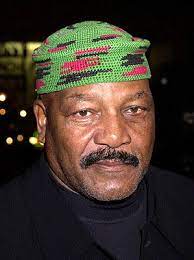 Jim Brown never lost his dedication to causes. I ran into him in the ‘90s, at some gathering in the city, I cannot remember the cause – health care and support for broken old football players, or racial causes. Whatever. Jim Brown was wearing a fez over his rugged skull, displaying a familiar hard look below the fez. Omigosh. I felt we were back in the late 60’s maybe in People’s Park in Berkeley, maybe outside Madison Square Garden or some other place that needed an attitude adjustment. The old days were back: Harry Edwards. Bill Russell. Roberto Clemente or Curt Flood giving writers a seminar in the clubhouse. Richie Havens. Nina Simone. Protest songs. The hallowed John Lewis. I saw a puzzled look on the face of a Black journalist, half my age, and I kind of giggled. Jim Brown’s scowl made me feel young again. And on the Manhasset-Port Washington peninsula, the earth still shudders from the powerful athlete who once played here. I can hardly wait to read the shop talk from Mark Landler, who does such a masterful job as the NYT’s correspondent based in London. Just the mention of coronations always makes me think of the great memoir of Russell Baker, who covered the 1953 ceremony for Queen Elizabeth, for the Baltimore Sun. (see below) Now, a great coronation output by Landler – my teammate during the Times’ coverage of the 2006 World Cup in Germany – on deadline, of the coronation of King Charles III on Saturday. (Landler was joined by a story on Queen Camilla by Megan Specia and a fashion Vanessa Friedman who has trained me to read her fashion essays.) Landler wrote a breaking news story with the lush details any Times reader would want – including, who was that lady in the blue-teal gown, carrying the sword? Why, it was Penny Mordaunt, the leader of the House of Commons – her very presence in the ancient ceremony another sign of inclusivity in not-your-grandparents’ England. Whether “we” should care about royals and coronations is another story. I checked, and my two rellies – Sam from the States and Jen from Australia – were not in their London base but rather in southwest France – and they were most decidedly NOT WATCHING. But I was, and so was the lady next to me, both of us with genes and family names and ancestry that go back to….well, in her case, William the Conqueror. (Me Mum was born in England but was decidedly a Churchill fan, not a royals fan.) Anyway, we gave the royals' production firm good marks for the visible Sikhs and Muslims and Buddhists plus the mention of Ephraim Mirvis, the UK grand rabbi, who was quartered near Westminster Abbey overnight to observe the Sabbath. (One favorite moment was the modern alleluia hymn sung and danced by the Ascension Gospel Choir, gracing the ceremony with their voices and their joy.) All of that was lavishly presented on the tube (anchored by Alex Witt, the weekend pro on MSNBC, with the indispensable Katty Kay back home in London, sending vital posts from a favorable spot on the parade route.) And soon the NYT will surely tell how its staff produced a masterpiece (color photos!) Speaking of shop talk: The landmark for coronation tales has less to do with young Elizabeth than with young Russell Baker, who had been posted in London by the Baltimore Sun, which in 1953 was a major, major American daily, always looking for young talent. Many decades later, as part of his memoirs, ("Growing Up" and "Good Times") Baker wrote about covering the 1953 coronation -- delightful details of how he scouted out a proper outfit for the ceremony, and how he packed a brown-bag lunch with two sandwiches and a few chunks of cheese and a tiny bottle of brandy to fortify himself during the long day. And how his wife, Mimi, was invited to a friend’s house where there was a TV set. Ever since Baker’s coronation tale was published, I consider it one of the inspiring great glimpses of a young journalist, being challenged by a great paper, and obviously succeeding, and how, decades later, Baker could recall the details of that assignment-of-a-lifetime. https://www.nytimes.com/1989/01/01/magazine/brown-bagging-it-to-buckingham.html **** Brown-Bagging It to Buckingham
By Russell Baker Jan. 1, 1989 MY INTENTION WAS TO become a great novelist, not a foreign correspondent, so naturally I never expected to end up in Westminster Abbey covering the coronation of Queen Elizabeth II. The chain of events that put me there began in 1947. The Baltimore Sun needed a police reporter that year. The managing editor mentioned it to an editorial writer who lectured at Johns Hopkins, and the editorial writer mentioned it to a professor, who mentioned it to me and gave me a phone number to call at The Sun. I was to ask for a Mr. Dorsey. Newspaper work didn't really interest me, but some great novelists had started as newspaper men. Newspaper people could never be much better than hacks. Still, they did write, didn't they? What's more, they got paid every week. I began to feel reality taking residence in my soul. ''What's your experience?'' Mr. Dorsey, The Sun's managing editor, was asking when I came to his office a few days later. ''I've worked on the Johns Hopkins News-Letter.'' ''You realize you can never get rich in the newspaper business,'' Mr. Dorsey said. ''Rich?'' I tried to smile the smile of a man calmly resigned to a life of penury. ''I never expect to make a lot of money.'' Mr. Dorsey sent me away with a handshake and a loud snort. A week later, the phone rang while I was eating supper. ''This is Dorsey. If you still want to work for me, you can start Sunday at $30 a week.'' I was flabbergasted. Thirty dollars a week. That was Depression pay. This was 1947. A pair of shoes cost $9. I'd been in New York a few weeks earlier, and the prices there were incredible. A theater ticket had cost me $1.50, the hotel was $4.50 a night, a sirloin steak restaurant dinner, $3.25. Thirty dollars a week was an insult to a college man. ''I'll take it,'' I replied. A MISFIT AT POLICE REPORTING, after a year on the job I was falling behind at The Sun. New people were being hired, assigned to police coverage for a month or two, then moved inside. ''Moved inside.'' On The Sun, those words meant having your own desk, being sent on fascinating general assignments, and never having to humor a policeman again. Luckily for me, The Sun's famously miserable pay had sent morale so low by 1949 that there was constant personnel turnover. Everybody seemed to be looking for a job with better pay, and many were finding them. This left the paper perpetually short of experienced reporters. As a result, to get ahead you didn't have to be very good, you simply had to hang around. Being unmarried and living at home, I could get by on my Sun salary, which averaged $50 a week in 1949, so I could afford to hang around. By the end of the year, I was making a gaudy $70 a week. This was enough to get married on, if you were young and foolish enough to believe in happy endings, which was precisely how young Mimi and I were. Then there came a miracle. The telephone woke me around 10:30 in the morning. I normally didn't get to bed until 4, so it was still dawn on my personal clock, and I growled a sour hello. THE MARTINIS CAME, THEN THE food and the beer, and when we started to eat, Buck Dorsey said, ''How old are you?'' I said I was 27. ''How would you like to go to London?'' he asked. The question was so preposterous that at first I did not absorb its implication. Well, I said, a little hesitant, we had just had a new baby, and I wasn't sure it was a good time to go off and leave Mimi alone. ''Could I think about it a little while?'' I asked. Buck Dorsey was looking at me very strangely, and as the full weight of his great announcement broke over me, I understood why: He wanted me to go to London. ''I mean, how long would you want me to be away?'' I said. ''Probably two years,'' he said. ''That's the usual assignment for men we put in the London bureau. Of course, once you get there and find a place to live, you'd move your family over with you.'' Then Buck Dorsey was talking about the coming coronation of young Queen Elizabeth, which would be the great story during my time in London, but I was now too excited to pay close attention. I was going to escape the drudgery of the local newsroom, after all. I ROSE AT 4:30 ON CORONATION morning and started dressing in white tie and tails. Heavy rain was beating against the window and it had been raining all night, drenching a million people camped in the streets. What should have been a rosy June morning looked like the start of a wet, black nightmare. I was going to have to walk out into that downpour in fancy dress because I had been too stupid to apply for a permit to take a car to Westminster Abbey. If I had filled out the forms, authoritative windshield stickers would have been issued, and I could have ridden in splendor. But I had laughed at the idea. An absurd fuss, a preposterous waste of car-rental money. Living within a short walk of the Abbey, I could easily stroll up there on a lovely June morning. It wasn't just chintziness that impelled me to walk. The American in me was tickled by the idea of walking to a coronation instead of being chauffeured by a lackey. Thomas Jefferson had walked to the Capitol for his first Inauguration. Let the English see how Americans did these things. Watching the rain outside made me curse my foolishness. That short walk to the Abbey seemed short only because I had never walked it in pouring rain. Actually, it was at least a mile. And in top hat, white tie, tails Instructions had been firm about dress. People not entitled to wear ermine, coronet, full dress uniform, court dress, levee dress coats with white knee breeches, kilt, robes of rank or office or tribal dress must wear white tie and tails, with medals. I didn't have medals. Since I didn't have a dressy suit either, I rented the full rig from Moss Bros., famous among the haberdashery-wise throughout the Empire and always pronounced ''Moss Bross.'' Knowing there would be a coronation run on Moss Brothers, I went early and got a fairly decent fit. Because I'd never worn tails before, I got up a little earlier than necessary against the possibility I might have a breakdown getting into the thing. Mimi fixed a big breakfast. It was going to be a long day. I had to be in position inside the Abbey by 7:30 and wouldn't get out until 4 in the afternoon. The rain let up while we were eating. Mimi got the camera and, while Kathy and Allen watched, took snapshots of Daddy wearing his coronation suit to show their grandchildren. Whatever gods may be, they were with me that day. The rain faded to a weak drizzle, then stopped altogether just when it was time to start for the Abbey. No, I would gamble and leave the raincoat home. Walking to the Abbey in top hat, white tie and tails could be a great gesture only if it were done right. Wrapping up in a dirty raincoat would make it comical. Mimi was going to the house of Gerry Fay, London editor of The Manchester Guardian, to watch the day's events on television. There weren't a lot of television sets in London yet, but Gerry's house had one, and his wife, Alice, had invited several disadvantaged families like mine to come see the show. Because it was a big day for me, as well as for the Queen, I kissed Mimi and the children goodbye, said, ''Wish me luck,'' stepped out into Lower Belgrave Street and headed toward Victoria Station. Not a soul in sight from Eaton Square all the way to Victoria. I strolled briskly along through the heavy, wet air, getting used to the feel of the high silk hat on my head, happy to discover that it was not going to tip and fall off. In my hip pocket I had a half-pint flask of brandy to keep me awake during the long day. In my hand, I carried a brown paper bag containing two sandwiches and three or four chunks of yellow cheese. In my pockets, I had a sheaf of official cards issued by the Earl Marshal, conveying the Queen's command for policemen to pass me safely through all the barricades and instructing me which church entrance to use, how to conduct myself while eating during the ceremony (discreetly), and where to find toilet facilities in the Abbey. Rounding Victoria Station, I heard the hum of a great, damp concentration of humanity. Packed from curb to building line on both sides, all along the five-mile route of the coronation procession, people had spent the rain-soaked night on the sidewalks. How many there were I didn't try to guess. The papers said millions, overstating it a bit, as newspapers usually do when writing of crowds. Still, there were plenty. I had walked among them the night before. They were bedded down in sleeping bags and soggy quilts, under raincoats and makeshift oilskin tents. Many had brought camp stools, portable stoves, knapsacks, picnic baskets, knitting bags, radios. They brewed tea on the sidewalk, they read, they slept, they sang, they sat stoically in the rain with only a felt hat against the downpour, they dozed with heads pillowed against tree trunks and lampposts. During the war, London's ability to ''take it,'' no matter how much punishment the Luftwaffe gave them, became such a cliche that it later turned into a small joke. On this cold, bitter, rainy night, with those good-natured hordes cheerfully camped on rainswept concrete, I had a glimpse of that peculiar British fortitude, dogged and indomitable in the face of adversity, which made them so formidable to Hitler. At the morning's soggy dawn, in my top hat and tails and graced, I hoped, with some of the elegance Fred Astaire brought to the uniform, I presented my credentials to the police guarding the barricades on the route to the Abbey. Miracle of miracles! The police recognized them, passed me through, waved me into the broad empty avenue called Victoria. The avenue ran straight to Westminster Abbey. I prayed I could make it before the skies opened again and stepped out as rapidly as I could without losing dignity before the damp mob staring at me. And, yes, now applauding me. A smattering of applause came off the sidewalks as I strode along. They had been waiting so long for something wonderful to appear. Now here was the first sign that wonders would indeed pass before their eyes this day. I fancied myself a vision for them, a suave, graceful gentleman in top hat, white tie and tails, signaling the start of a momentous event. At that moment, I was the event. The applause grew as I stepped along. Having always prided myself on shyness, modesty and distaste for theatrics, I was surprised to find myself not only enjoying my big moment, but also, here and there, where the applause seemed especially enthusiastic, tipping my silk hat to the audience. It wasn't until I got within a block or two of the Abbey that I understood what was happening. There I noticed a man in the crowd talking to a companion and pointing to my hand holding the brown bag with my lunch. At this, his companion laughed, then applauded vigorously: What delighted the crowd was the spectacle of a toff brown-bagging his lunch to the coronation. By this time, I was certain to reach the Abbey before the downpour resumed. That certainty and the pleasure of strutting a great stage exhilarated me. Triumphantly, I raised my lunch over my head and waved it at the crowd, and was washed with a thunder of cheering and applause that the great Astaire himself might have envied. A moment later, I passed into the Abbey for a long day's work. I HAD A GOOD SEAT IN the Abbey. It was in the north transept looking down from about mezzanine level onto the central ceremonial theater. It provided a clear, unobstructed view of the Queen and the throne in left profile. Opposite, in the south transept, sat the lords and ladies of the realm in scarlet and ermine. The few good seats allotted to American correspondents had been distributed by a lottery drawing, and I had got lucky. After being ushered up the ramp to the chair I was to occupy for the next seven or eight hours, I took a spiral note pad out of my pocket and began taking notes, just as I would have done at a three-alarm fire in Baltimore. This was by design. After worrying for weeks how to cover a coronation, I had decided to cover it pretty much the way I would cover any routine assignment on the local staff. I would show up, keep my eyes open, listen closely and make notes on what I saw and heard. My hope was to produce a story that seemed fresh, and I thought this might be possible if I treated it as though I'd just strolled into the newsroom one afternoon and the city editor had come dancing at me, shouting: ''They're having a coronation up at the Abbey in 10 minutes. Get up there as fast as you can.'' This was not the safe way to cover the coronation, but it offered the best chance of doing a good story. The safe way was to write the story before the coronation was held. This was also the surest way to produce a lifeless story. This idea I discarded quickly. For one thing, I was cocky about my ability to produce a fresh story of several thousand words under deadline pressure. I had always worked well on deadlines, maybe even better than when there was time to dawdle. So I entered the Abbey with no backup story ready to send in case of emergency, took out my spiral pad, and started jotting notes on what I saw. Tier upon tier of dark blue seats edged with gold. The stone walls draped with royal purple and gold. The stained glass of rose windows transforming the gray outer light into streams of red, yellow, green and blue high up against the Abbey roof. Many of these notes appeared almost unchanged. ''Yellow men and tan men, black men and pink men, men with cafe au lait skins and men with the red-veined nose of country squiredom.'' ''Malayans with bands of orange and brown-speckled cloth bound tightly about their hips. . . .'' ''Men dressed as Nelson might have dressed when he was sporting in London . . . like courtiers who dallied with the Restoration beauties of Charles II's court . . . like officers in Cornwallis's army. . . . ''. . . violins far away eerily unreal. . . .'' Writing to my mother later, I disposed of the coronation in a single paragraph: ''I am so sick of the whole business that I can't write about it. Suffice it to say that I was in the Abbey about 7 and didn't get out until 4 P.M. In this time, I ate two sandwiches, several chunks of cheese, went to sleep three times, and drank a half pint of brandy to keep my blood flowing. I was seated in the midst of all the African and Oriental potentates and had a fine view of the staircase leading down to the water closets, where I could see Africans in leopard skins and Chinese dressed like French admirals queuing up to wait their turn to make water. I came out of the Abbey, stiff as a board and woozy, and had to run through a cold driving rainstorm to find a taxicab. Then I had to write for six hours, producing that mass of type which ran in The Sun. I didn't feel that I laid an egg completely, because next day mine was the only story from any American newspaper which had parts reproduced in any of the London papers. Considering that papers like The New York Times and Tribune had 25 and 30 reporters to do the job, I felt we did fairly well.'' The humility in this last sentence was entirely bogus. By the time I wrote my mother, the reaction from Baltimore was in, and I felt I had done far better than fairly well. I felt I had scored an absolute triumph. The day following the coronation, I had a cable signed by 16 members of the city staff. It said: ''Magnificent. Your coverage worthy of the coronation, and of Baker.'' Pete Kumpa, one of the best newsmen on the staff and an old friend whose regular correspondence kept me posted on events in the home office, reported: ''Your story received here in the greatest admiration. Magnificent is the word.'' The greatest ego bloater of all, however, was a note from Buck Dorsey's wife, Becky, marked ''Very Personal.'' She reported various compliments about the coronation piece which Buck had received from various high and mighty types in the Sun hierarchy, then said: ''The nicest of all, Tom O'Neill, said, 'Buck, the boy knows how to use the English language. It's a finished piece, beautifully done.' '' O'Neill was the most dashing reporter on The Sun. Closing, Becky wrote, ''I do not know that Buck would approve of my telling you all this, but on thinking of that fine ignorant old face of yours, I couldn't help myself.'' I could have discounted praise from my friends on the city staff. They had been writing glowing reviews from my very first days in London. They were my cheering section back in Baltimore, and for good reason. Being picked from the local staff for The Sun's plum assignment abroad, I was a symbol of hope for them. If one man from the local staff could escape into the sweet world of foreign correspondence, there might be hope for all. They had a stake in seeing me succeed and wrote constantly, applauding and cheering me on to keep my morale high. Becky's report about Tom O'Neill, however, was not so easily explained away. Nothing could have done more to puff me with self-admiration than those few words about Tom O'Neill's remarks to Buck. I was not the type to have wildest dreams, but if I had been, the wildest I could have concocted would have had Buck Dorsey listening with the respect he always accorded his favorite reporter as the great O'Neill heaped me with praise. Two months after the coronation had crowned me with glory, my triumph was confirmed in a cable from Baltimore: ''Ten dollar merit raise effective next week for you. Happy August Fourth and all that. Love. Dorsey.'' That brought my salary up to $120 a week. I was a $6,240-a-year man. **** Russell Baker is a columnist for The Times. This article was adapted from his book, ''The Good Times,'' to be published by William Morrow & Company in June. A young Black man is shot knocking at the wrong door. A young woman is killed after her car pulls into the wrong driveway. And then there are the police shootings. People are trigger-happy, and I know when it got worse – back in 2016 when a real-estate grifter and reality-show character ran for the presidency. He was sending a message to a huge segment of America that it was time to get tougher. Just look the sneers and cheers behind the bad actor, as he goads them into action. People were getting dumber, by choice, and a swath of the country welcomed his message to gear up. America as a reality show was on my mind as I read an analysis of the late Jerry Springer by Jane Coastan in The New York Times on Saturday. She describes Springer as a kind of Dr. Frankenstein who got caught up in his own monster, but she also suggests that he knew what he was doing, all along. Reality shows pay well. I never watched the grifter’s show (having met him a few times) and I never watched Springer’s show, either but I did pay attention to him because he was another Queens guy (Forest Hills HS) and had gone into politics in Cincinnati when I was living down-river in Louisville. Turns out Springer and the more dangerous reality show buffoon were both descended from Germany – one was a Jewish refugee, born in a makeshift maternity ward in the Underground in wartime London, the other whose father attended Nazi Bund rallies and lived in posh Jamaica Estates, Queens. They both understood their audiences. One went into politics to play to the angry white people in America, the other went into television to play to people who liked life on the violent and kinky side. The young grifter also knew the violent side – somebody who would know has told me about the grifter’s father being bandaged all over, recuperating at home after some kind of organized beating. Lesson learned: Just give some orders and people will go out and break some bones. That’s what he was suggesting at his rally in Las Vegas in February of 2016. His subtle political message: How he would like to punch that heckler. Just let me at him! But America has become too soft to allow that kind of frontier justice. Still, thanks to the gun merchants and the Republican lawmakers and the sour Americans waiting behind their front doors, we have quickie frontier justice – and students being shot up in school, and legislators banning the elected messengers. Plus, Charlottesville. Good and bad on both sides, right? America has always had guns. I moved to cover Appalachia in 1970, and some journalist pals at the Louisville Courier-Journal (now terminally Gannett-ized) told me about the television journalist in 1967 (from dear, sweet Canada!) who ignored the warning not to intrude, and was shot dead. The recluse served a year. Yes, I thought about that every time I needed to knock on a door in some distant holler. But now the violence is spreading. People go to political rallies, packing. The grifter is finally facing legal justice, after a wasted year from the sclerotic Justice Department. And good grief, he's threatening to run again. RIP, Jerry Springer. All he did was give Americans what they liked in bestiality and incest and brawling. Seems so innocent now. (Marty Goldman has written this tribute to Michael Spivak, our mutual classmate at Jamaica High School in Queens in 1956, and something of a folk legend. Marty was the valedictorian and Michael was sixth in our class -- quite an accomplishment for both, considering there were over 850 June graduates. Let me hastily add: I was in the third quadrant.
By Marty Goldman It is with sadness that I report the passing of our Jamaica High classmate, Michael Spivak. Michael may not have been known to everyone in the Class of ’56, but he was my friend and he just bowled me over with his math brilliance. He was barely 16 at graduation. There he received a top Math Prize, won an award for English and accompanied our Choir on piano. I remember a conversation we had while we were waiting to get into the JHS cafeteria. He was telling me about a book he was reading for pleasure - Bertrand Russell and Alfred North Whitehead’s Principia Mathematica, which explored the foundations of logic and set theory. At that point I realized that I didn’t have his degree of the curiosity, patience and deep intellect required to become a successful career mathematician. So, what became of this precocious, talented person? Simply this: his writings, sense of humor and reclusiveness made him a legend in the world of mathematics! After JHS, Harvard and a PhD in Math at Princeton under the renowned John Milnor, he began writing math textbook after textbook. However, these were no ordinary textbooks! Consider, for example, what is said about his 1967 book, Calculus. Bloggers call it, “The greatest Calculus book of all time,” (https://www.youtube.com/watch?v=oave4Z939as) and “The most famous Calculus book in existence,” (https://www.youtube.com/watch?v=huSD6GysL6k). A review article by the Mathematical Association of America (MAA), states, “This is the best Calculus book ever written” (https://www.maa.org/press/maa-reviews/calculus-4). It was not his first Math book. Two years earlier, at twenty-five years old, he published a little textbook, Calculus on Manifolds: A Modern Approach to Classical Theorems of Advanced Calculus, which has been translated into Polish, Spanish, Japanese and Russian. This book explained what is known about Calculus on surfaces and volumes in higher dimensions – even beyond three. The book is described as, “elegant, beautiful, and full of serious mathematics,” in a review by the MAA. While writing his books, Spivak taught as a full-time Math Lecturer at Brandeis University. In 1967 he won a year-long National Science Foundation Fellowship to Princeton’s Institute for Advanced Study, where Einstein had taught and struggled, in vain, to develop a theory unifying gravity with the other fundamental forces in nature. When Spivak returned to Brandeis it was as Assistant Professor of Mathematics. At this point the usual academic career move for a mathematician would be to publish significant original research papers, which serve as the imprimatur for promotion to Associate Professor and, eventually Full Professor with tenure – a lifetime job. However, this was not the path followed by Michael Spivak, who turned away from the customary academic career in favor of an iconoclastic career as an author – a prolific, much-admired sole author – and eventually as a publisher and science popularizer. During his three years as Assistant Professor of Mathematics at Brandeis, Spivak continued to write books, while teaching classes. In 1970, his last year as Assistant Professor, he published the first two volumes of what would become a five-volume masterpiece with the daunting title, Comprehensive Introduction to Differential Geometry. More later about the sensation this set of books produced in the math community. After leaving Brandeis, Spivak was no longer on a conventional academic track, although he continued to give lectures at universities like Berkeley and in Bonn, Germany. By 1975 the first edition of the five volume, Comprehensive Introduction was published. Thus, by age 35 Spivak had published seven books. His reputation among mathematicians was growing but it was increasingly difficult to track his whereabouts and impossible to learn anything about his personal life. He began to acquire a cult following. Spivak’s new projects were often surprising and witty. He created a Canadian TV series, Science International, featuring many short segments dealing with an eclectic assortment of topical scientific and technical issues. Science International was later brought to U.S. TV as, What Will They Think of Next? (IMDB). Next, he founded his own publishing house, Publish or Publish, which produced the second edition of his five-volume opus as well as other works by him and others. In order to deal with the difficult art of typesetting mathematical formulas in his publications he extended the equation-editing program, TEX (pronounced “tec”), and documented his contributions in a treatise entitled, The Joy of TEX. He also invented one of the first gender-neutral set of pronouns called the Spivak Pronouns and wrote The Hitchhiker’s Guide to Calculus. In 1985 he received the American Mathematical Society’s highest award for expository mathematical writing, the prestigious, Leroy P. Steele Prize for his five-volume Comprehensive Introduction to Differential Geometry. His PhD advisor won the same award, years later. The citation from the American Mathematical Society reads, “In the ten years since its completion, this work has become a kind of classic of its own, providing the reader with important insights into the development of the subject, a well-selected set of central topics, and a unique and exhaustive annotative bibliography. Furthermore, it is written in a lucid and informal style that makes reading it a pleasure. An earlier "classic" by Spivak is his Calculus on Manifolds, one of the first books to make available to an undergraduate audience the basic concepts and techniques of differentiable manifolds and differential forms.” (Notices of the AMS., October 1985 Issue 243, Pgs. 575-576) His response was, “It was as gratifying as it was surprising to learn that I was to receive the Steele Prize for my books on differential geometry. When I made my first intrepid, not to say foolhardy, attempts to fathom the multi-media world of differential geometry, I certainly hadn't anticipated completing a work of such outlandish proportions. I hope this award will encourage others on similar ventures and show that they can be accomplished even from the periphery of the academic world.” (Notices of the AMS., October 1985 Issue 243, Pgs. 575-576) 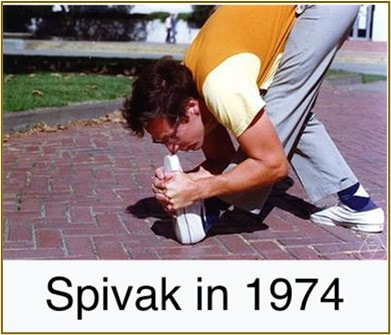 Spivak had a lifelong interest in Physics and wrote a book called, Physics for Mathematicians: Mechanics. It is described in a Wikipedia article about him, which contains the photograph below, left. What is he doing in this photo and how is this pose even possible? It is rumored that in each of Spivak’s books there are hidden references to yellow pigs, an idea Spivak apparently came up with at a bar while drinking with David C. Kelly. Michael Spivak’s productive, colorful and unconventional life sadly came to an end on October 1, 2020, at age 80 in Houston, Texas. Details, unfortunately, are not available. We can all justly take pride in the lifetime of accomplishments of our classmate, Michael Spivak. *** From George Vecsey: My thanks to Marty Goldman for volunteering this informed essay. I only wish more had been written about Michael Spivak when he passed, after breaking a hip, according to snippets on the Web. One of Spivak's accomplishments has widespead implications these days: his scholarly creation of gender-neutral pronouns, very much an important subject these days. https://wiki.c2.com/?SpivakPronouns https://www.liquisearch.com/spivak_pronoun https://en-academic.com/dic.nsf/enwiki/105747 https://www.quora.com/What-impact-did-Michael-Spivaks-books-have-on-you-He-died-in-2020  The May 23, 1956, issue of the Hilltopper, with the lead story announcing that Michael Spivak had been awarded a National Merit Scholarship and that Martin Goldman had also earned a scholarship. The article was by Walter Schwartz, the editor for much of the year, which is why I call him "Chief." Hail to the chief for digging this clip from his files.
Using tango music and the physical concussion of boots stomping on the floor, the ballet follows the unwanted little girl who grows into a dance-hall performer who captivates Juan Perón. But she is followed by her childhood self, a waif in a plain white gown, who quietly materializes at key moments, to haunt Evita. Perhaps the best part of this ballet, from choreographer Annabelle Lopez Ochoa, is performed by the eyes – with camera closeups revealing the emotions of Evita, (Dandara Veiga), fearing her past will be revealed. My wife and I have decided that this ballet might be the best we have ever seen. *** I have always been something of a snob about TV -- soaps, game shows, series (i was obsessed with "The Sopranos.") However, while staying close to home in recent years, I have opened my mind, at least a bit. Every Saturday and Sunday morning, we seek out the Aerial America series on the Smithsonian channel -- hour-long views of the states. Sometimes we “visit” states we do not know very well – like New Mexico and Arizona. My wife, born in Connecticut, with genes from early settlers of Rhode Island and Massachusetts, loves the aerial views of New England. Today the series returned to Maine, which we discovered in the past decade from visiting her uncle Harold, who lived in Bath, a few yards from the Kennebec River, which he had helped dredge before World War II. Harold is gone now, but the Smithsonian cameras take us to coastal scenes so familiar we could taste the fresh catch at Bet's Fish Fry in Boothbay, A swoop over Brunswick showed the home of author Harriet Beecher Stowe near downtown Brunswick – with an old red-brick mill converted into urban offices and shops – “Look, there’s our Thai restaurant!” If we were a bit younger, if there were no Covid, we’d be visiting more of Maine, and other parts of this blessed continent. In recent months, we have seen documentaries of singers who have been part of our adult lives. Joni Mitchell was honored by the Gershwin award, at the Kennedy Center, beaming in the front row, as people praised her music, her idealistic messages. Joni has been recovering from a stroke, but -- spoiler alert: -- on this recent night, she agreed to go to the microphone and in an older, huskier but still blatantly Joni voice, she totally aced the Gershwin standard, “Summertime.” https://www.google.com/search?q=joni+mitchell+honored+at+kennedy+center&rlz=1C1GCEA_enUS874US874&oq=Joni+Mitchell+honor&aqs=chrome.3.0i512j69i57j0i512l3j0i22i30l4.18076j0j7&sourceid=chrome&ie=UTF-8#fpstate=ive&vld=cid:4cc10676,vid:C815lySYh9w Another documentary showed how Roberta Flack started singing classical music – not an easy path for a young Black woman -- and over the years how she took control of her own career. We try not to miss the series, “Now Hear This,” with American conductor-violinist Scott Yoo traveling all over the world to talk music with classical musicians. In all the fields I have covered, I have loved shop talk – from coal miners, from athletes, from politicians, who know their field and, if encouraged, will divulge tricks of the trade. The other night, Yoo explored how Robert Schuman may have been bipolar, interviewing a doctor/musician who can talk and play Schumann. Finally, CNN has been running a series with the actress, Eva Longoria, exploring the food of Mexico, region by region. Longoria, born in Texas of Mexican ancestry, visits contemporary restaurants in Mexico City and is at her best visiting the countryside, chatting respectfully with the earnest women who farm and cook and also trek into the cities to sell their wares.
Recently, Longoria was in the Yucatan peninsula, not just Merida, but the tidal flats where she learned to sift for salt. She also watched the deliberate process of the regional specialty -- baked pork, cochinita pibil -- in a covered pan, underneath a layer of dirt, overnight, for 8 to 12 hours. https://www.cnn.com/videos/travel/2023/03/06/yucatan-mexico-cochinita-pibil-eva-longoria-origseriesfilms.eva-longoria-searching-for-mexico It’s been two decades since I’ve been to Mexico – a soccer match against the USA. It brought back memories of reading travel adventure books by Richard Halliburton in grade school. (Longoria did not mention the human sacrifices into deep wells that Halliburton explored so many decades ago. ) Longoria’s series makes me want to go back to all the places I've visited -- Puebla, Monterrey, and next time Oaxaca. For the moment, I’m thankful to contemporary television for the documentaries that take us so many places, At the moment, Sunday afternoon, TV will take me to another corner of the world -- Oakland, A's vs. Mets. 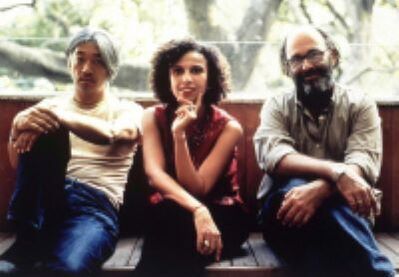 A master has died. Ryuichi Sakamoto was an innovator, transcending styles and mediums. He was so productive that the New York Times ran a lush and knowing obituary on Monday -- yet never mentioned my favorite work involving Sakamoto-san. "Casa" did not make the cut, squeezed out by work for movies ("The Last Emperor" for Bertolucci), modern collaborations with David Bowie, a performance at the opening ceremony at the 1988 Summer Olympics. He was transplanted into my brain, my heart, two decades ago when I was listening to John Schaefer, New York's jewel of a music teacher, with his familiar radio show, "New Sounds." Late one evening, Schaeffer's new sound was a CD entitled "Casa" -- "Morelenbaum2 Sakamoto" -- a cellist with a beard (Jaques Morelenbaum), a beautiful singer (Paula Morelenbaum), and a pianist (Sakamoto) -- all three interpretating the music of Antonio Carlos Jobim. La casa? The interpretetations evolved in the home of the late Tom Jobim, in Rio, and later recorded in studios in Rio. Rarely do you see creative genius intermingling, so respectfully. Jacques Morelenbaum suggests (in thick English) a dramatic piano chord to end one song, as Sakamoto nods his mane, Paula Morelenbaum reclines casually on a sofa, then out of nowhere she tries out a phrase in Portuguese or maybe English. Over the years I realized that Sakamoto lived in Greenwich Village and later I read that he was fighting cancer. Then on Monday I read a lush and informed obituary by William Robin in The New York Times. Sakamoto was 71. Favorite new fact? His influences ranged from Claude Debussy to John Cage (who has been one of my wife's favorites for many years.) Maybe you can access the link to Sakamoto's obituary in Monday's NYT: https://www.nytimes.com/2023/04/02/arts/music/ryuichi-sakamoto-dead.html And maybe you will enjoy the interplay among these artists, courtesy of YouTube: Brother-sister Web banter, Wednesday evening: Dave: “Fact: The day before opening day is the longest day of the year.” Laura: “That’s the tweet du jour. An ode.” Dave: “The coldest winter I ever spent was the day before opening day.” * * That’s a lot of responsibility to put on any sport – to make things right with the world. It used to be that baseball’s major chore was to make people feel warm after a long, cold, lonely winter. Here comes the sun. * * But the stakes are higher these days, what with Donald J. Trump still stinking up the world. It's hard to get excited about anything, any sport, with hundreds of thousands of Americans dead of Covid because that “administration” would not administer. It's hard to worry about a pitcher's injury or a batter's slump compared to Russia’s war crimes in Ukraine, committed by the dictator who turns Donald Trump into a stammering schoolboy. It's hard to wonder how your team will do this season while America's children are being mowed down in schools, which apparently is okay with the political party in thrall to Donald Trump. I saw that Rep. Tim Burchett of Tennessee ("We homeschool") shrugging off the slaughter of the innocents in Nashville, with the disdain of a true worshipper of Donald Trump. Still, on a frigid day up north, I was eager for the opening days of the two New York teams because I need a break from the dismal news in my newspaper of choice olus radio and television stations. Some fans were excited by the possibilities on opening day, with baseball opening a season with a full slate of games. All teams were in the position Casey Stengel used to take with new seasons, new players: “They aint failed yet,” he said, when he was managing the Mets, always looking for the Youth of America. You can make a case for the restorative powers of opening day. My father played hooky on April 18, 1923, to watch the first game in the new Yankee Stadium – Babe Ruth against his old team, the Red Sox. Although Pop was a Brooklyn Dodger fan, and later a Mets fan, he loved to tell me about the thrill of cutting high school to see The Babe, and he recalled the construction rubble around the new ballpark. Years later, when I was based in Louisville, the NYT assigned me to drive alongside the Ohio River to cover two traditional home openers in Cincinnati, in respect for the original Red Stockings, the first professional team. Rose and Bench and Perez, cold and damp, but tradition being honored. Baseball doesn’t do that for Cincinnati anymore, and something has been lost. Mets fan that I am, I eagerly tuned in the Yankee opener on radio station WFAN, with John Sterling and Suzyn Waldman, whom he sometimes calls “my compañera” – John’s shtick, Suzyn’s knowledge. They were bristling with baseball – Aaron Judge’s home run into Monument Park behind center field at the Stadium, and the debut of Anthony Volpe, from Manhattan and New Jersey, age 21, making his debut with a uniform patch that said “MLB Debut” -- the Youth of America, Casey's dream. I was planning a pensioner's doubleheader on opening day, recalling how I had attended the Mets’ first home game in 1962, as a fan, in the funky old stopgap home, the Polo Grounds. A sharp wind made raindrops sting like needles, and the old Mets stumbled around in the field, a portent of years of epic but charming clumsiness. On television Thursday, there was the triumvirate of Gary and Ron and Keith, so comfortable with each other, and then I switched to Good Old Howie Rose on the radio, who closed the victory with his trademark, "Put it in the books!" Midway through the game, my cellphone began pinging, and instead of baseball details I was receiving news that Donald J. Trump had been indicted in the case of paying a stripper to cover up the brief liaison he had with her. (The stripper said it was 90 seconds. His life changed in 90 seconds.) Finally, after all the contemptuous behavior of Donald J. Trump and his lackeys, and the unproductive legal shuffling by Robert Mueller and Merrick Garland, a grand jury in New York has returned an indictment. So what if it isn't the biggest violation we know Trump did -- planning a seditious raid on Congress on Jan. 6, 2021, leaning on the governor of Georgia to "find" some non-existent votes, hiding classified federal documents in his playpen in Florida. As somebody just said to me, "This is the perfect indictment for a sleazebag." A good beginning. So I didn't have anything more to type about Opening Day. All I wanted to do was read the stories on the Web, plus to the experts, the lawyers, the journalists. I grew up in Queens, less than a mile from the Trump house on Midland Parkway. I know people who were close to the Trump household, who regarded nasty little Donald as a bad seed. He's been getting away with stuff for seven decades, with the smirk of a spoiled kid. Finally, somebody has had the courage to act on Donald J. Trump. Let me start by saying Babe Ruth is my favorite athlete, all-time.
Not just because I witnessed him, last game of 1947, clearly sick, addressing a crowd in Yankee Stadium. Not just because he had coached for my Brooklyn Dodgers for a while. Not just because I later met his daughter who talked about “Daddy.” I consider him my favorite athlete because he could pitch and he could hit and he could entertain fans just by being “The Babe.” Now I can say, I have also seen Shohei Ohtani pitch and hit in the same game, for the World Baseball Classic, holding off the Americans with skill and power and flair, just like the Babe. Whatever else is wrong with the world at the moment – don’t get me started – there is this versatile champion from Japan, thrilling fans around the world. By now, you undoubtedly know that Ohtani saved Japan’s victory over the United States late Tuesday evening (Eastern time), closing the game by striking out his Los Angeles Angels teammate, Mike Trout, with a hellacious slider that broke clear across the plate. If there is anything you don’t already know about Tuesday’s championship, try to log on to Tyler Kepner’s column in the Times, written right after the game. https://www.nytimes.com/2023/03/22/sports/baseball/shohei-ohtani-world-baseball-classic.html Tyler touched all the bases, with gusto and knowledge, writing: “ The tournament, it is safe to say, is no longer taking off. It is already in orbit.” The Babe, it is said, saved baseball by hitting more home runs than anybody had ever done, 29, while still a starting pitcher for the Boston Red Sox in 1919. In the same year, some members of the Chicago White Sox conspired to lose the so-called World Series, in a gambling plot, followed by sleazy legal maneuvers by the hangin’ jury of the baseball leadership. The Yankees purchased Ruth, who promptly hit 54 home runs and entertained the world (including Japan, on a barnstorming visit) for a decade and a half. Now, Shohei Ohtani has pushed the baseball tournament toward the grand tournament for the world’s most popular sport, soccer/football, the World Cup. In its own quadrennial tournament last fall, Argentina’s elder superstar Lionel Messi held off France’s young superstar Kylian Mbappé in an exciting final. Baseball still has a long way to go, around the world, but at least Ohtani has nudged his sport into the discussion of world events. Ohtani made baseball a 24-hour spectacle. I confess, as a notorious early bird, that I have rarely caught a glimpse of Ohtani (or, for that matter, Mike Trout.) I’m a Mets guy, a National League guy. But now Ohtani, with one inning of smoke, has inserted himself into worldwide consciousness. I woke up Wednesday morning and found an email from our friend Fumio, who used to live across the street on Long Island – such nice people, I think of him and Akie every day. back home in Japan. I replied to Fumio that as a baseball fan and a journalist, I recognized that the “story” was this poised young superstar holding off his Angels teammate and the American all-stars. It is now 105 years since Babe Ruth pitched and hit the Red Sox to a “world” championship. Imagine. One hundred and five years. An accomplishment I can legitimately label “Ruthian.” Finally, a kind word and a mature stance in the ugly standoff in American men’s soccer. Gio Reyna, all of 20 years old, has been chosen for the national squad in two matches later this month, as well he should have been. “As far as we’re concerned, Gio is a part of our program. He’s a good guy and a top talent and he is evaluated like any other player,” said Anthony Hudson, the interim coach of the national team. Reyna was the most controversial American player on the U.S. squad in the disappointing World Cup last fall. Apparently, he contributed to his bad standing by moping when thwarted. He is, did I mention, only 20. But the so-called adults and leaders came off worse. This is one of the saddest stories in the history of men’s soccer – involving two teammates from the 2002 team in South Korea that made the best standing ever by the U.S. in a World Cup. Claudio Reyna played the best match I ever saw from him on the national team – distributing the ball, holding the defense together from midfield. He was brilliant as the U.S. humbled Mexico – dos a cero -- in the round of 16. Gregg Berhalter nearly scored in the quarterfinal match against Germany, but a German defender just happened to stick his arm in the path of the close shot by the American defender. The referee ruled that the defender did not commit a hand-ball infraction – but several former German stars at the match later said the U.S. should have been awarded a penalty kick. (In his best Lawn Guyland sarcasm, American coach Bruce Arena grumped, “That’s nice.”) Reyna and Berhalter. Two decades later, Berhalter was the coach of the American World Cup squad in Qatar last fall, making the decisions, including telling young Gio Reyna, a promising player in the Bundesliga, that he was not likely to get much playing time because…because….well, it’s not clear. How to Lose a Promising Young Player, by Gregg Berhalter. Reyna has had injury issues, and apparently his attitude went downhill from there, and he played bits of two American matches. Meantime, his parents, Claudio Reyna and Danielle Egan Reyna, herself a former national player, were grumping in the stands, telling people they knew bad stuff about Gregg Berhalter, and if it ever got out…. What the Reynas knew was that when Berhalter was in college, he was dating Rosalind Santana, a member of the college women’s team, and the two 18-year-olds had an argument in a bar, and she slapped him, and he kicked her in the legs, and the brawl was broken up by a stranger. Berhalter told school officials, sought counselling, and the following fall Santana contacted Berhalter and they have been married for two decades. Berhalter’s judgment about Gio Reyna may have been questionable, given the young player’s swivel-hipped instincts in cutting through defenses. However, Berhalter’s judgment as a leader was even worse. After the World Cup, Berhalter was invited to speak in a private meeting of business people – officially off the record – and he discussed “leadership” decisions he had faced including a certain player who acted up during the World Cup. Needless to say, word got out. This is how to lose face with players, forever. Finally, finally, the so-called leadership of the U.S. Soccer Federation contacted a legal firm to investigate all aspects of the Reyna-Berhalter incident. The report came down this past week, finding no legal faults by anybody, leaving the decisions up to the federation. What should happen now? Berhalter is technically a candidate to regain the job. I can’t say I was impressed with his coaching during the World Cup mission, and in my opinion the blatant allusion to Gio Reyna in a business speech makes him a poor candidate for a second term. (His personal life, his marriage, an incident 20 years ago, is not an issue, as the legal report points out.) And what about Claudio and Danielle Reyna, who apparently were bad-mouthing Berhalter all over Qatar during the World Cup? Unhappy parents are part of every level of soccer, but I think Claudio Reyna, deservedly a member of American soccer hierarchy, had a responsibility to behave better. And then there is this: While Claudio was playing the best soccer of his career in the 2002 World Cup, Danielle Egan Reyna was a personable presence around the team hotel in Seoul, pregnant with their second child, who in November of that year would become Gio Reyna. Nearly a decade later, the Reynas’ first child, Jack, came down with a lethal form of brain cancer, glioblastoma, and he died in July of 2012. The other day, when the legal report came out, I went online and found a touching article about the Reynas’ terrible loss. I would suggest anybody should read this before forming an opinion about the Reynas – what they have been through, how they describe Jack, the ideal big brother for Gio and two subsequent children. Also, please note that this beautiful article was written by one of best writers ever to cover soccer, Grant Wahl, of Sports Illustrated. Last fall, during the World Cup in Qatar, Grant slumped over and died at his desk in the press tribune. https://www.si.com/soccer/2018/12/12/claudio-reyna-family-jack-death-giovanni-dortmund#gid=ci0254f6cdc0022511&pid=jack-reyna-giovanni-1jpg Part of Grant’s legacy is this description of the humanity of the Reyna family. Also, I would propose reading the words of the aforementioned Anthony Hudson the interim coach. He does not have a public reputation as player or coach, but he sounds like an adult who knows a thing or two about leadership, and that is no small thing. “We had the issue at the World Cup that we dealt with internally, that we dealt with as a group,” Hudson told Mike Woitalla of the valuable site, Soccer America, adding, “There was a positive response from Gio after that … and we all moved forward. “The World Cup ended, and beyond that it became a very, very, complex situation that we see as separate from Gio, even though he’s impacted by it. ... But as far as we’re concerned, Gio is a part of our program. He’s a good guy and a top talent and he is evaluated like any other player. We made the roster decisions based on what gives the team the best opportunity to win these games, and we brought him in because we think he can help us do that.” Gio will be with the U.S. squad in two Concacaf Nations League games at Grenada on March 24 and vs. El Salvador in Orlando March 27. After all that has happened, Gio Reyna deserves the chance to grow up, to go forward, to find open space, no matter who the coach is. ### THIS JUST IN: FRIDAY, MARCH 17 In Soccer America Daily, an article by Paul Kennedy, "Christian Pulisic backs Gregg Berhalter in face of 'childish' controversy." Pulisic, who has learned patience from his time with Chelsea, speaks positively about Gregg Berhalter's chance to return as coach: "Everything that happened with Gregg, first of all, has been handled in an extremely childish manner," Pulisic said. "I think we've seen what has been going on. I think it's childish, it's youth soccer, people complaining about playing time. I don't want to go too far into that, but I think Gregg has been extremely unfortunate to get into the position he's in now." https://www.socceramerica.com/publications/article/95566/christian-pulisic-backs-gregg-berhalter-in-face-of.html?edition=29569 The report commisioned by the US Soccer Federation:
https://ussoccer.app.box.com/s/ycsf3xneaqbph329kilqy5upmk45sotbussoccer.app.box.com/s/ycsf3xneaqbph329kilqy5upmk45sotb (15 MARCH 2023. BEWARE THE IDES OF MARCH.)
AS OF WEDNESDAY MORNING, I HAVE RENEWED CONTACT WITH THE WEB COMPANY. I'LL TRY TO ADJUST TO NEW CONDITIONS IN NEXT FEW DAYS. THANKS FOR THE NOTES, YOU HARDY FEW WHO NOTICED I HAD BEEN DISAPPEARED. TO BE CONTINUED. MAYBE. IT IS, AFTER ALL, THE IDES OF MARCH. GV Rupert Murdoch's star agitator, Tucker Carlson, is sharing the secrets of his squirrelly heart, via internal e-mail. He says he hates Donald Trump, as opposed to the slavish adoration he shows on Fox Fables. How to explain this? Your explanation is welcome on Comments. (below) Meanwhile, Alex Murdaugh is locked up, permanently. Rupert Murdoch may be out a billion dollars or more for emitting falsities about the Dominion company and called it "journalism," when he actually admits they are lies. I was wondering about the two blokes with similar names a couple of weeks ago, wondering if they are related, so I looked it up. “Originally, the name was a nickname for a person associated with the sea,” says the website, House of Names. The name Murdoch derives from one of two Gaelic names which have become indistinguishable from each other. The first of these, Muireach, means belonging to the sea or a mariner. The second name is Murchadh, which means “sea warrior.” As for the other man in the news: The name “Murdaugh” is “an altered form of Murdoch,” according to “The Dictionary of American Family Names.” I do not mean to make light of the terrible events in South Carolina that sent Alex Murdaugh, a so-called scion of an old family off to prison in handcuffs, convicted of the murders of his wife and younger son. And there are other deaths in the backdrop, including a Murdaugh family housekeeper who died, perhaps from falling downstairs, or perhaps not. (At the very least, the scion stole her insurance money.) That is a tale of privilege and money and also the contemporary usage of drugs. I wouldn’t have minded seeing an occasional mention of the family that profited from OxyContin (and the doctors and pharmacists and flat-out criminals who doled them out like candy, hooking thousands of poor people as well as a lawyer and “scion” with too many toys in lowland South Carolina.) We are left with the image of a wife apparently on the verge of separation, and one son (“the little detective”) discovering more piles of OxyContin, both murdered, and the older son sitting in court, thinking, what? Also in the news is the similarly-named Murdoch, Rupert, who has been infecting public discourse going back to his origins in Australia. He brought his sniggering style of “journalism” to Great Britain and then to the United States. I still remember when a quirky liberal tabloid, the New York Post, morphed into a Murdoch property in the 1970s. Soon we were treated to the Page Six gossip of a lightweight real-estate poseur who would brag about the women he had slept with, allegedly. For many, that was the first time they ever heard the name “Trump.” So we have Rupert Murdoch to thank for that. Recently, in the manner of ganglords, Rupert Murdoch turned on Donald Trump when he began losing at the polls. A Post headline referred to “Trumpty-Dumpty” after recent congressional elections. However, Fox television continued to make money from blather by its commentators – most scandalously in the wake of Jan. 6, 2021, when Trump’s legion of thugs attacked the Capitol. The most famous names on Fox – I cannot even type their names, and of course I never, ever, watch them – stuck with their on-air position that Jan. 6 was a picnic for gentle tourists. In their spare time, however, these paragons of Fox journalism ridiculed some of the buffoon lawyers supporting Trump, and they acknowledged that Trump did lose the 2020 election. But tell that to their viewers out there? People like Tucker Carlson worried about the company profits. “They endorsed,” Mr. Murdoch said under oath in response to direct questions about the Fox hosts Sean Hannity, Jeanine Pirro, Lou Dobbs and Maria Bartiromo, in a $1.6-billion defamation lawsuit by Dominion Voting Systems, the New York Times reported. “I would have liked us to be stronger in denouncing it in hindsight,” he added, while also disclosing that he was always dubious of Mr. Trump’s claims of widespread voter fraud. Now he tells us. Rupert Murdoch has testified that he knew his stars really did not believe the lies they were spewing on-air. He sounds a bit dazed from recognizing reality. But his words are out there. Rupert Murdoch does not believe what makes him rich. So much for journalism. Alex Murdaugh has been sentenced to two life terms. He’s yesterday’s news, sad and horrible news. Rupert Murdoch created a media empire that disregards truth – a television network that helped send thousands of thugs climbing into the American capitol building. Rupert Murdoch undermined a nation, leading to a Gaetz-Greene-McCarthy infestation in Congress. (Can he be deported?) Now his empire is being sued. Apparently, over half the Fox stock is owned outside the Murdoch dynasty. If Murdoch’s acknowledgements ultimately hurt the product -- bad ratings = defections by sponsors – the Murdoch dynasty could be in trouble. Your comments about the strange psycho-drama with Carlson and Trump, and the bizarre hiccups of reality from Rupert. Under "Comments:" |
Categories
All
|



